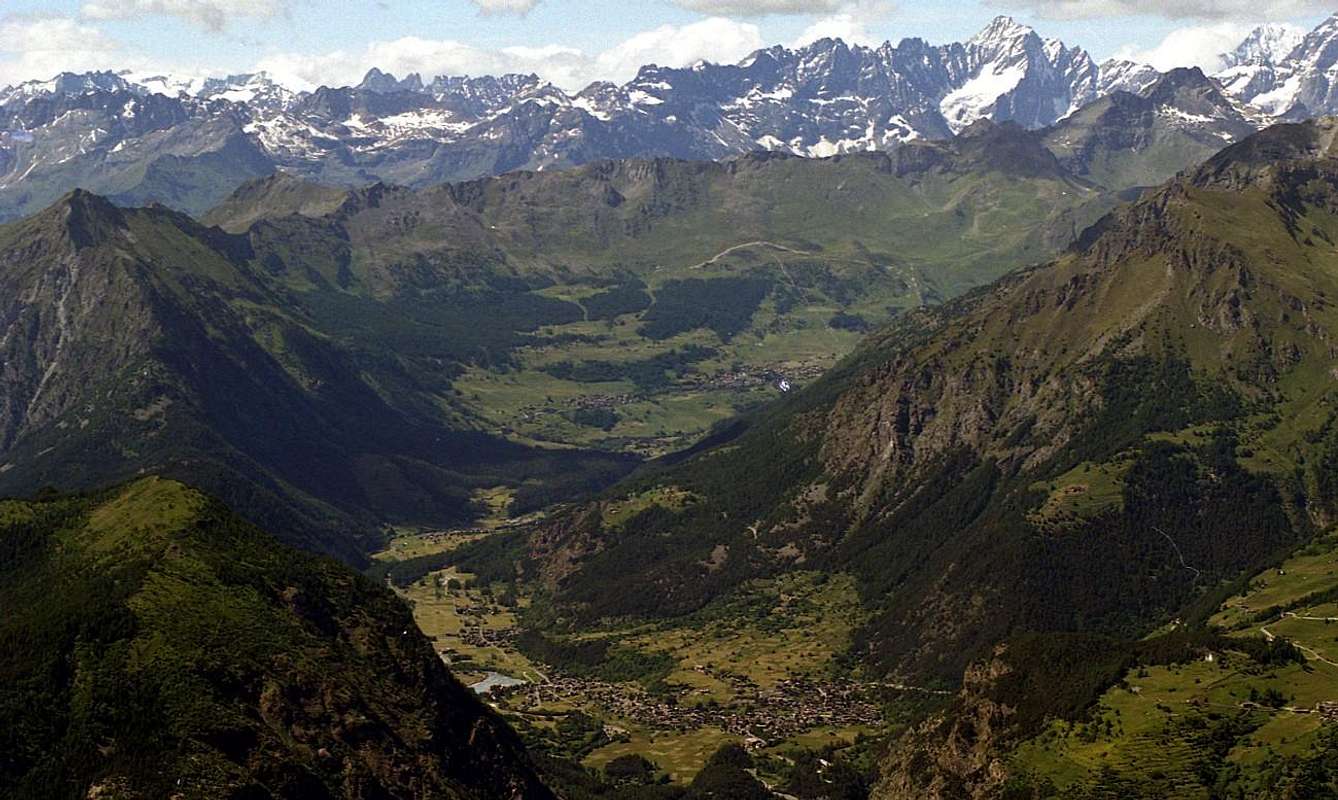-
 3543 Hits
3543 Hits
-
 81.18% Score
81.18% Score
-
 13 Votes
13 Votes
|
|
Route |
|---|---|
|
|
45.87250°N / 7.65647°E |
|
|
Hiking, Mountaineering, Trad Climbing |
|
|
Spring, Summer, Fall, Winter |
|
|
One to two days |
|
|
From F to PD- |
|
|
Note
|
La montagna chiama i suoi figli, ed essi rispondono fedelmente al suo appello… Osvaldo Cardellina, Diario alpinistico, 1964-65 Page texts: @ OsvaldoCardellina "Osva", passed away on May 2, 2022. Page owners: Christian Cardellina e Osvaldo Cardellina. Any updates from September 12, 2022: Antonio Giani, page administrator, friend and climbing companion. Testi della pagina: @ OsvaldoCardellina "Osva", scomparso il 2 maggio 2022. Proprietari pagina: Christian Cardellina e Osvaldo Cardellina. Eventuali aggiornamenti dal 12 settembre 2022: Antonio Giani, amministratore della pagina, amico e compagno di salite. |
Overview
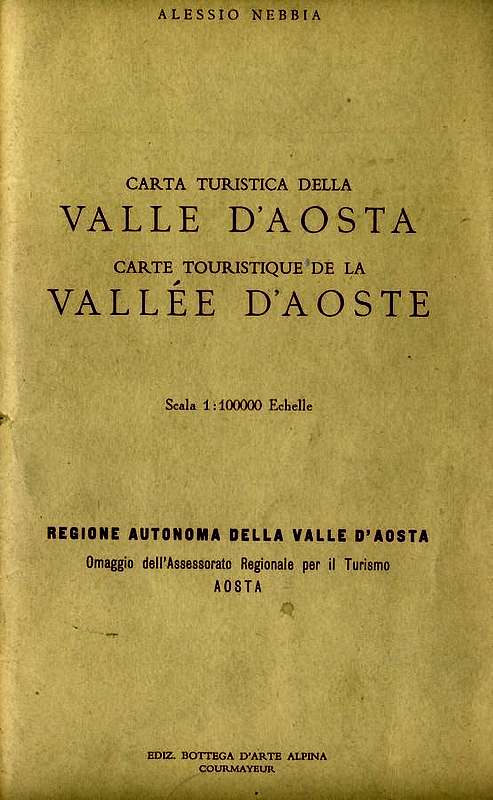

Seven are also considered the requirements for basic routes description, with the elasticity of only two factors missing for each, which can be summarized in this way:
1) - : paths or marked trails, or failing this, simply always detectable both up during descent and where possible coincident. In any case always easy to identify and to follow.
2) - : easy route with itineraries aimed at E (Walkers) or EE (Expert Hikers), with the occasional use of the upper limbs; difficulties on rock from F (Easy) At the F+ ((middle intermediate grade more), with steps not greater hardly ever than I°/I°+ (U.I.A.A. Scale or Union of the International Mountaineering and Climbing Federation).
3) - : lack of glaciers or marginal traverses on thereof; snowfields or presence of glacial-snow-capped with a slope of no more than 30/35 degrees and possibly free of crevasses.
4) - : possibility of having at not great distances good support points as camps, bivouacs or shelters, generally always well marked along the entire way.
5) - : in the absence of these, there are points of cover from the elements as natural shelters, caves in the rock, Alps or "Casotti" (Cabins) by the Parks or Forest Rangers Huts.
6) - : absence of large and more or less obvious objective dangers over the path (falling stones, landslides, avalanches, snowslides or simply collapsing scaffoldings glacial).
7) - : vantage point of first order of the entire valley visited, possibly central and still to allow the full view on the same and in distance at least over a part of the Valley of Aosta.
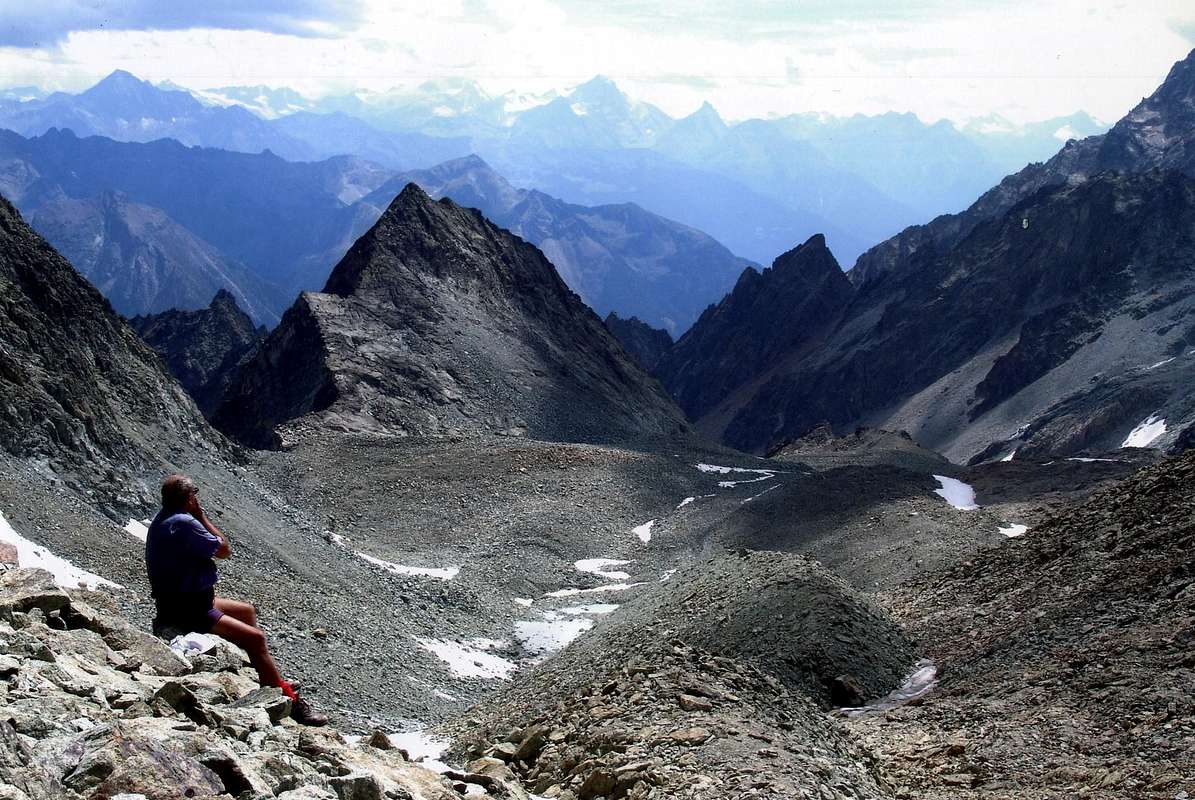
Partendo questa volta da Occidente e verso Oriente queste son quelle interessate e discendenti in direzione della Dora: Valpelline, le tre adiacenti Combe di Viou, Senevé e Dèche, Valle di Saint Barthélemy, il Bacino di Verrayes-Saint Denis, Valtournanche, Val d'Ayas, la Valle di Gressoney od anche conosciuta quale Valle del Lys.
Sette, inoltre, sono i requisiti per la descrizione degli itinerari di base ed altri, con l'elasticità di solo due fattori mancanti per ognuna, e così in sintesi riassumibili:
1) - : sentieri o percorsi segnalati, oppure in mancanza, sempre semplicemente individuabili sia in fase di salita che discesa, laddove possibile coincidenti ed inoltre piuttosto facili.
2) - : facilità della via con itinerari rivolti ad E (Escursionisti) oppure ad EE (Escursionisti Esperti), con l'utilizzo saltuario degli arti superiori; difficoltà su roccia da F (Facile) al massimo a F+ (Facile superiore), con passaggi che non vanno quasi mai oltre il I°/I°+ (Scala U.I.A.A. o dell'Unione Internazionale delle Associazioni Alpinistiche).
3) - : mancanza di ghiacciai od attraversamento marginale dei medesimi; presenza di nevai o glacio-nevati con pendenza non superiore ai 30°/35° e possibilmente non crepacciati.
4) - : possibilità di avere a non grandi distanze buoni punti di appoggio come accampamenti, bivacchi o rifugi, in genere sempre ben segnalati lungo l'intero percorso.
5) - : in mancanza di questi, esistenza di punti di riparo dalle intemperie come ricoveri naturali, grotte, Alpeggi o Casotti dei Parchi o della Forestale (attenzione, in genere privati).
6) - : assenza di grandi e più o meno evidenti pericoli oggettivi sovrastanti il percorso (cadute di pietre, possibilità di frane, valanghe, slavine o semplicemente crolli glaciali).
7) - : punto panoramico di primordine sull'intera vallata visitata, possibilmente centrale e comunque tale da consentire la vista completa sulla medesima nonché in lontananza.
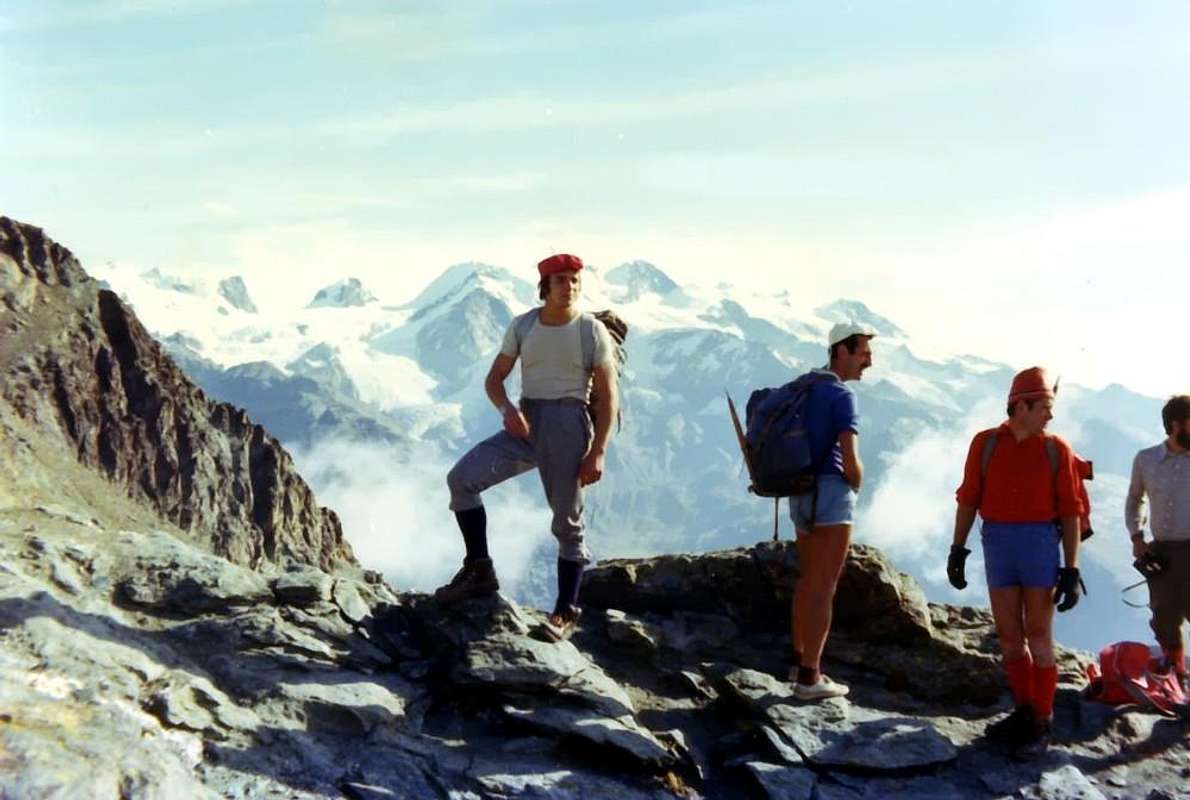
Getting There
BY CAR:- From TORINO, MILANO, etc: Motorway A5. Exit at IVREA or Quincinetto (PIEDMONT).
- From IVREA Town: in West (Southern side) to Pont Saint Martin, Verrès, Châtillon, Nus, Aosta in West and to Gignod, Valpelline, Oyace and Bionaz Municipalities in Northeast from Aosta Town.
- From Courmayeur Resort: in East-southeast (Norheastern side) to Aosta, Gignod, Valpelline, Oyace, Bionaz Municipalities in Northeast and to Nus, Châtillon, Verrès, Pont Saint Martin Communes to South-southeast.
Northeastern Side:
From Valpelline towards Valpelline Valley
- From Valpelline (580m), with Regional Road, to Oyace Commune (1.316-1.377m); from this to Northern and Southern Walloons (Brison, Crête Sèche, Vertsan, Comba be la Tsa, Comba du Grand Chamin, Comba des Lacs and Comba d'Orein up to the entrance on Petite/Grande Murailles/Valpelline Hill Vallon.
- From Oyace (1.377m), with R.R., to Bionaz Commune (1.612m) and Places Moulin artificial Dam (1.970/80m) and Northern and Southern Vallons (Bella Tsa, Combes de Valcornière, Livourneaz, Montagnayes; Vessonaz, Verdonaz, Vieille, Verdzignolaz, Arpisson, Gran Comba and Roisan-Praperiaz Basin.
Southern Sides:
From Nus, Châtillon, Verrès, Pont Saint Martin Municipalities towards Saint Barthélemy, Valtournanche, Val d'Ayas and Gressoney Valleys.
- From Nus (960m), with Regional Road, to Lignan-Saint Barthélemy Municipality; from this, through various dirt roads and numerous paths, (1.628m) up to the Becca de Luseney (Luca Reboulaz Bivouac (2.575m neighbor the Luseney Lake), Livourneaz Pass 2.840m and Cian Fenêtre (2.736m).
- From Châtillon (549m), with Regional Road, to Valtournanche and Breuil Cervinia Municipalities (2.004m); from this, through paths in West, to Tsan Bivouac, Lake (2.489m, 2.441m), Cignana Lake (2.149m) or, through dirt road and paths more in East, to Gran Sometta (3.166m).
- From Verrès (549m), with Regional Road, to Champoluc and Saint Jacques Communes (1.697m); from these, path in West, to Grand Tournalin Refuge (2.544m). From shelter, through path in North, to Mont Brun (2.895m); also in valley floor to Lake Bleu (2.211m) and in East to Pinter Pass (2.776m).
- From Pont Saint Martin (345m), with Regional Road in Gressoney Valley, to Gressoney La Trinitè (1.468m); from this, through dirt roads and paths in East, up to the Upper Bettolina Pass (3.058m); also in West to Gabiet Loch (2.363m) and from this, with path, to Corno del Camoscio (3.026m).
- From FRANCE: through the Mont Blanc Tunnel to Entrèves-crossroads to Vény/Ferret Valleys - Courmayeur. By Little Saint Bernard Pass, closed since November until half May to La Thuile Valley - Pré Saint Didier - Courmayeur. It is not necessary to take Motorway A5: you can drive on SS.26, in the direction of AOSTA - IVREA - TURIN.
- Aeroporto "Corrado Gex" Saint Christophe (Aosta).
30 Routes and more Description

It is designed to identify the most suitable excursion to the parameters predicted and that the best way to represent a valley, in general all the proposals are aimed at ascents ranging on average between 2.750 to 3.350 meters with a few exceptions. However it has also tried to offer alternative opportunities, presenting on the single territory other two proposals; the same are more equally synthesized but always containing all the basic information you need. Or simply to provide more tips and suggestions, with the division into three bands enough diversified.
Band One: is the basic tour designed to represent the specific valley; is described in detail, numerous annotations, timing only indicative and various suggestions.
Band Two: Excursion similar to the previous one, with the same altitude but also in less differentiated (usually) or more; viewpoint completely different from the first proposal.
Band Three: Excursion of less effort and duration and also, more suited to the path even with children or boys, also to use as "backup" in case of uncertain weather.
Si é pensato di individuare la Escursione più consona ai parametri predetti e tale da rappresentare nel modo migliore una valle, in genere tutte le proposte sono rivolte ad ascensioni che vanno mediamente tra i 2.750 ai 3.350 metri con qualche eccezione. Comunque s'é cercato d'offrire anche opportunità alternative, presentando all'interno del medesimo territorio altre due proposte; le stesse sono maggiormente sintetizzate pur contenendo ugualmente tutte le indicazioni di base necessarie. Oppure semplicemente per offrir ulteriori suggerimenti e proposte maggiormente variegate, con la suddivisione in tre fasce ben diversificate.
Fascia Uno: gita di base atta a rappresentare la specifica vallata; viene descritta con dovizia di particolari, numerose annotazioni, tempistica solo indicativa e suggerimenti varii.
Fascia Due: gita similare alla precedente, con altitudine uguale o differenziata in meno (generalmente) od in più; punto panoramico completamente diverso dalla prima proposta.
Fascia Tre: Escursione di minor impegno ed anche durata, più adatta al percorso anche con bambini o ragazzi, da utilizzarsi come "riserva" in caso di tempo incerto.
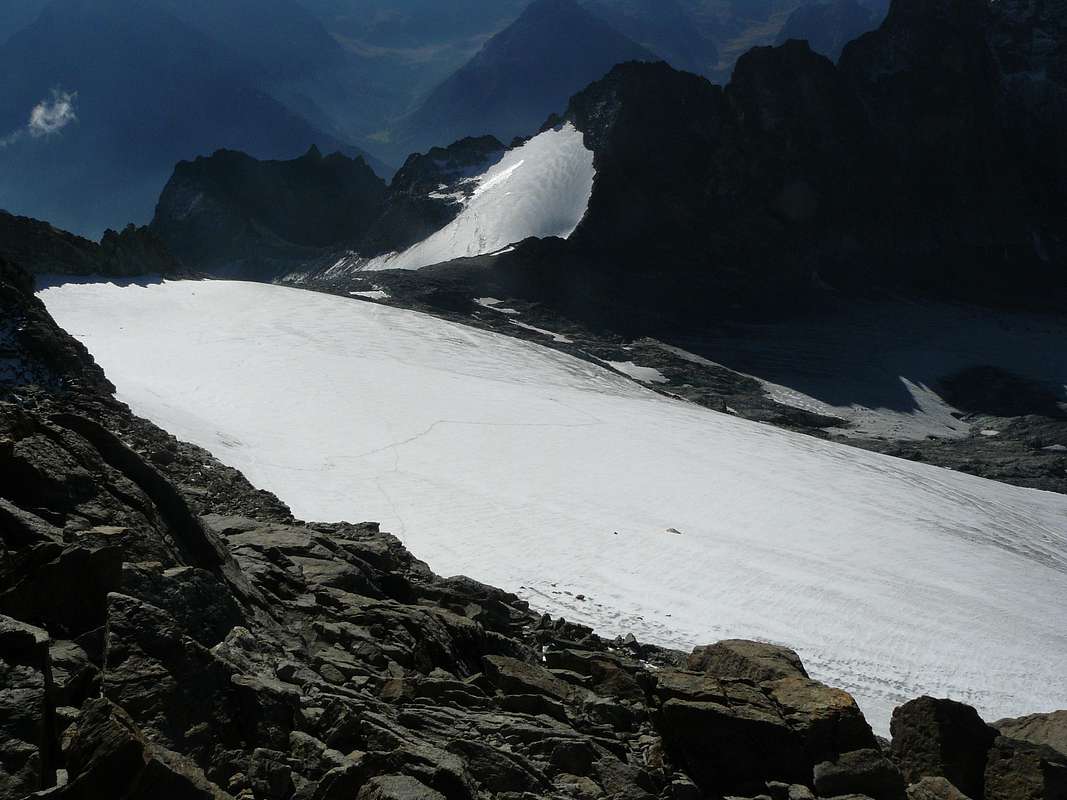
1/A) - Mont Gelé (3.518m)
1/A) - Mont Gelé (3.518 m)
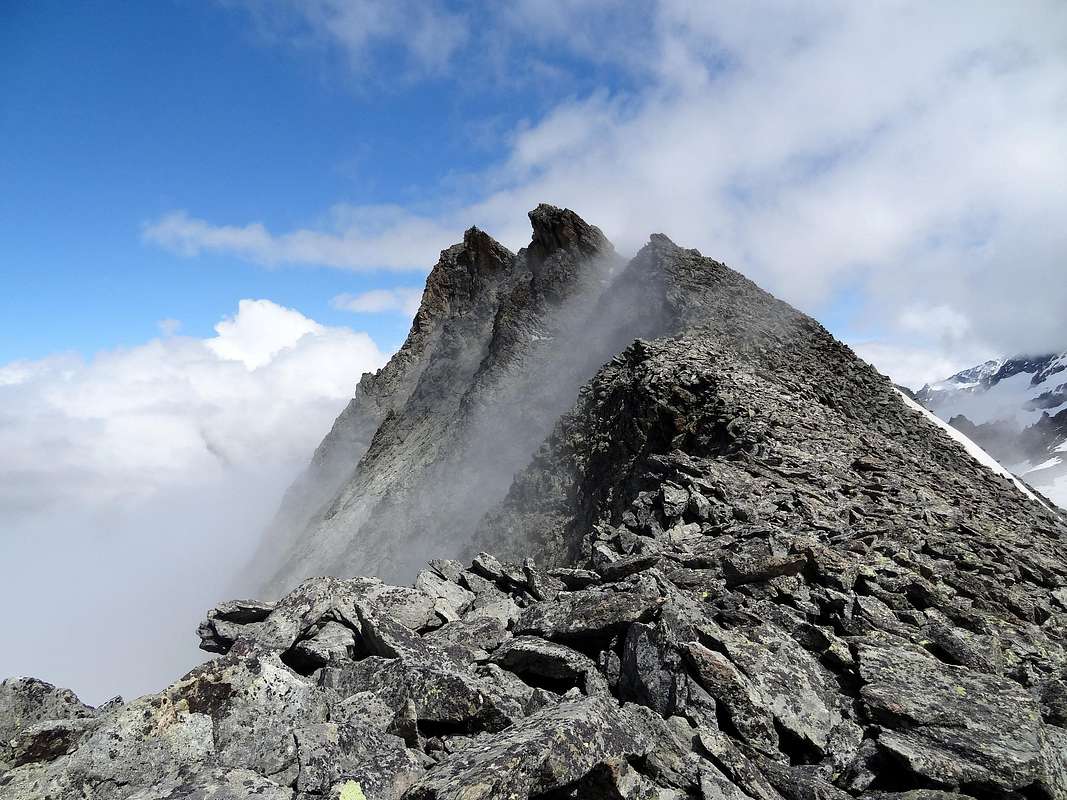
1/B) - Trouma des Boucs (3.263m)
1/B) - Trouma des Boucs (3.263 m)
Avvicinamento dal Villaggio di Ru o Ruz: dal Rifugio di Crête Séche o dall'ex Bivacco Franco Spataro attraversare il "Plan de la Sabbla" indirizzandosi verso il Colle di Crête Séche (2.899 m), ma non raggiungere il medesimo. Superata verso destra la quota 2.906 metri ripiegare verso la parte alta della Comba de Crête Séche e senza percorso obbligato raggiungere il Col Chardoney (3.186 m), sottostante il Pic e la Becca Chardoney (3.282/3.447 m). Da questo percorrere la facile Cresta Sudest e, superato un tratto più impegnativo formato da alcune asperità, un intaglio ed una breve placca nella parte terminale, raggiungere il piccolo ometto della Sommità (EEA; 2h'45/3h'15 dal Rifugio di Crête Séche).
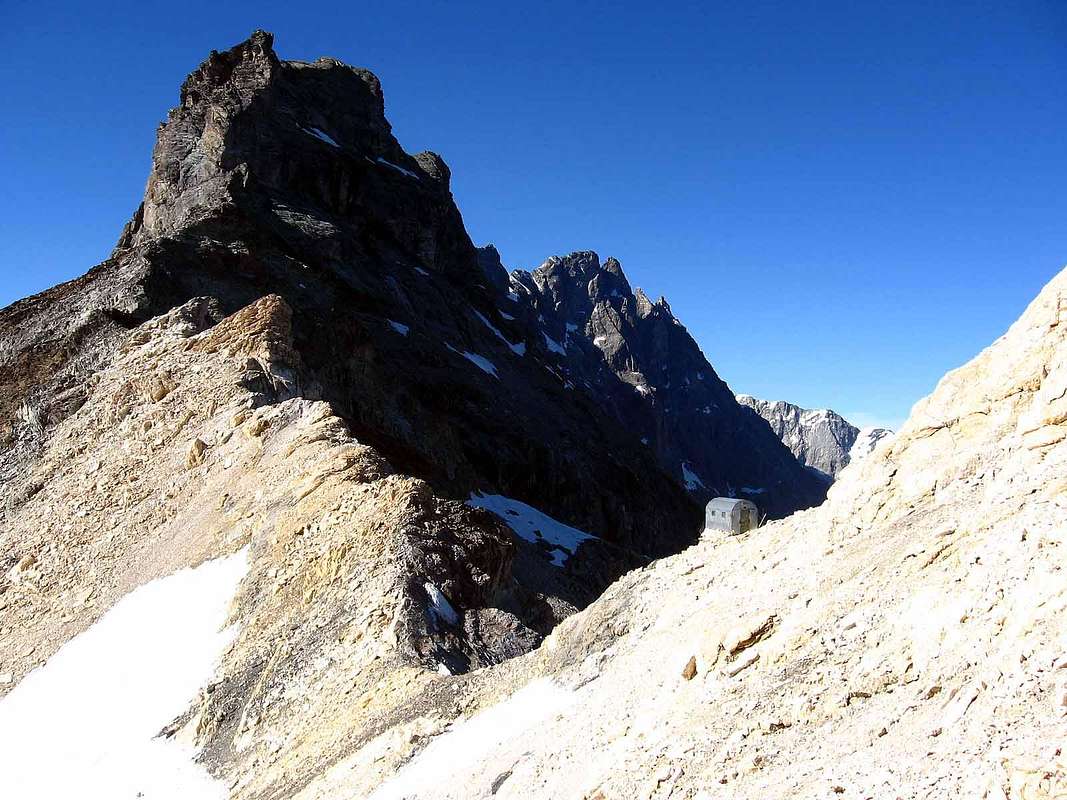
1/C) - Mont Blanc de Creton (3.406m)
1/C) - Mont Blanc de Creton (3.406 m)
Avvicinamento dal Comune di Bionaz : da Bionaz risalire al parcheggio di Places Moulin (1.968 m); da questo iniziare percorrendo la strada poderale a Settentrione del lago artificiale, che conduce al Rifugio di Prarayer (2.005 m), quindi per il sentiero n° 9/10/11 alle pendici del bosco di larici Bois de Grand Plan. Lasciare a Nord il bivio per il Rifugio Aosta salendo verso Oriente con sentiero n° 11 e superarndo gli Alpeggi di Gordzé (2.154 m), Deré la Vieille (2.254 m) e Bella Tsa (2.474m). Oltrepassato il torrente, proseguire alla base della morena laterale destra del Ghiacciaio del Château des Dames su sentierino non numerato o tracce. Risalire il ghiacciaio verso il Col des Dames (attenzione ai crepacci) con pendenze varianti dai 25° ai 35°. Prima del colle, lasciato a sinistra il versante Nordovest, salire direttamente il pendio che porta all'Anticima Sud (3.400 m) su terreno misto con roccette biancastre e rotte, donde in breve per la Cresta Sudovest si raggiunge la Vetta (EEA/F+; 4h'00/4h'30 da Prarayer; 5h'00/5h'30 dal parcheggio).

2/A) - Becca di Viou (2.856m)

2/A) - Becca di Viou (2.856 m)
2/B) - Becca di Roisan (2.546m)

2/B) - Becca di Roisan (2.546 m)
Avvicinamento da Blavy verso l'Alpe Praperia: all'inizio della strada sterrata (oltre il traffico è consentito solamente ai mezzi autorizzati) lasciare l'auto e iniziare la salita a piedi lungo la strada sterrata poderale conducente all'Alpeggio di Praperia(z) (1.737 m). Risalire subito dopo dietro l'Alpe, prendendo un sentiero non numerato dapprima verso Sudest, attraverso i prati in direzione di una recinzione, e poi percorrente il bosco verso Est-nordest. Seguire il medesimo per un poco di tempo ma, appena al di sopra di un rudimentale e minuscolo "chiosco" attrezzato ad area Pic Nic dagli abitanti del posto, abbandonarlo spostandosi maggiormente sulla sinistra (Est e poi Nordest). Gradualmente dirigersi verso una grande fascia di rocce oblique dirigentesi verso un'appena accentuata crestina, che risale in fin dell'estremità inferiore della corta Cresta Ovest della Becca di Roisan. Proseguire per un valloncello-canalone molto ripido su grandi blocchi e "clapeys", formanti una naturale ed altresì ripida scalinata, raggiungendo una piccola conca di grandi macigni ed alcuni nevati, proprio ai piedi della piccola nonché ripida parete rocciosa, che la montagna lascia cadere verso Sud. Da questa, e tramite un pendio di roccette rotte, erba e detriti, risalire alla Crestina Sudest finale, sullo spartiacque tra i Comuni di Roisan e Valpelline, e percorrerla fino in Vetta (E/F; 2h'30/3h'00 dall'Alpe Praperia(z).
2/C) - Becca de Blavy (2.508m)
Approach from Blavy Hamlet: directly departing from the Village of Blavy (1.475m) through the path n° 1/25/105 and therefore through a more start in more low level (1.475 meters against 1.737 precedents), but surely more forehand and express, at least towards the Quota (2.508 meters), and surely through path of best quality up to the meeting with the private dirt road "poderale". For the conclusive part, or in the small basin among the Becca of Roisan and the aforesaid quota, the characteristics of the anticipated one they are similar entirely (EE/F+; 3h'30/4h'15). The same one, therefore, can constitute a Variation of Approach, diversified by the departure by Praperia(z).

2/C) - Becca de Blavy (2.508 m)
Avvicinamento dal Villaggio di Blavy: partendo direttamente dal Villaggio di Blavy (1.475 m), tramite il sentiero n° 1/25/105, e quindi tramite un avvio più in basso come livello (1.475 metri contro 1.737 precedenti), ma sicuramente più diretto e rapido, almeno nei confronti della Quota (2.508 metri), e sicuramente tramite sentiero di migliore qualità fino all'incontro con la strada sterrata poderale nonché privata. Per la parte conclusiva, ovvero nel piccolo bacino tra la Becca di Roisan e la quota predetta, le caratteristiche del precorso sono del tutto similari (EE/F+; 3h'30/4h'15). Il medesimo, quindi, può costituire una Variante di Avvicinamento, diversificata dalla partenza dall'Alpe Praperia(z).
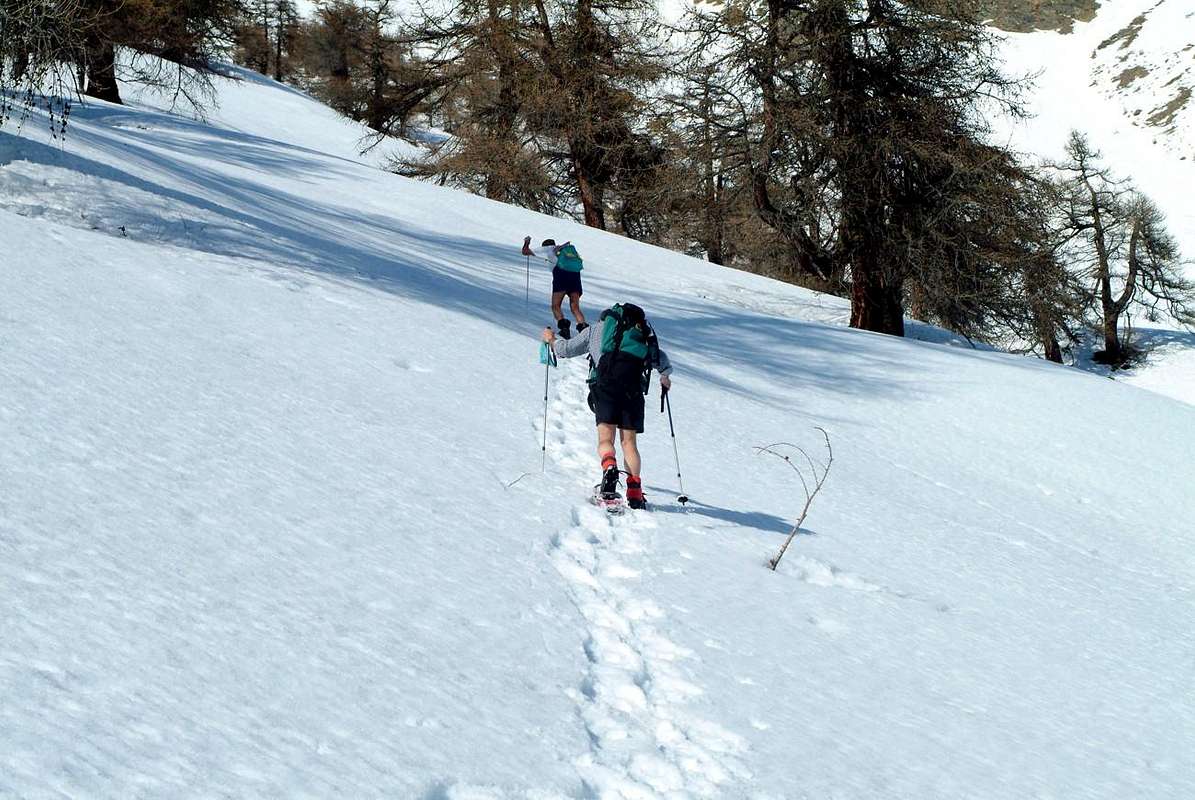
3/A) - Mont Mary (2.815m)
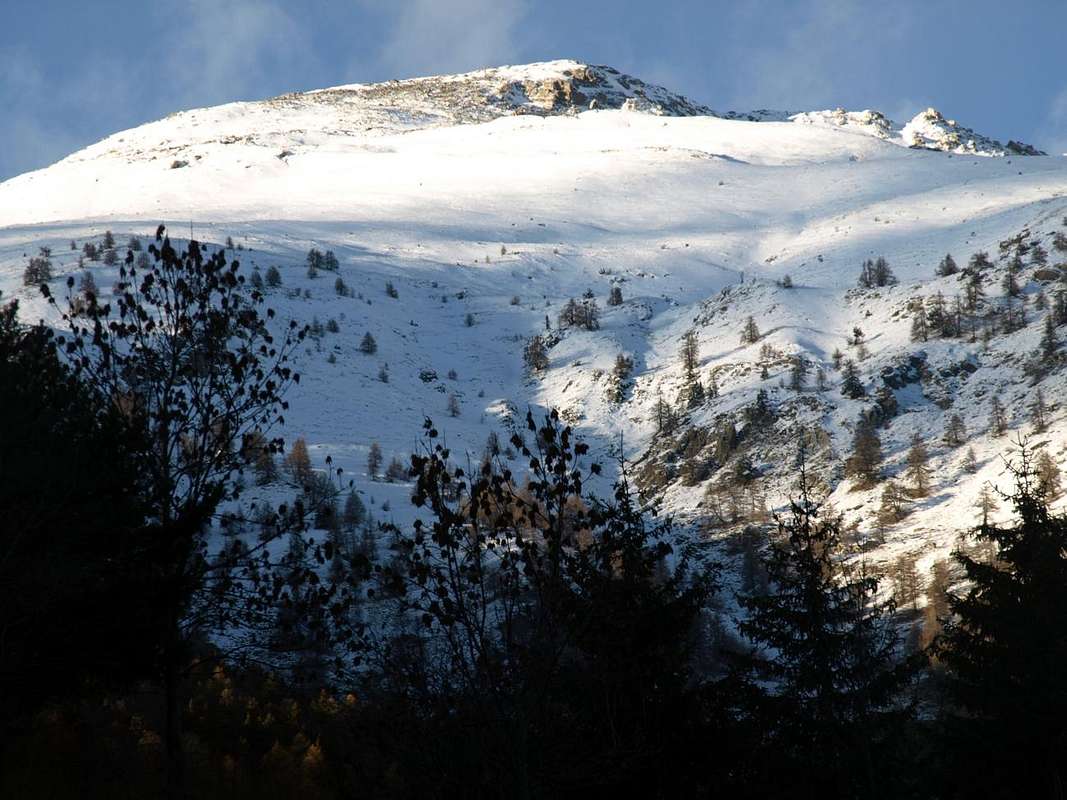
3/A) - Mont Mary (2.815 m)
3/B) - Becchi di Fana (2.951m)
Approach and route from Trois-Villes-Avisod Hamlet through Senevé Comba and "Passo Alto": from the Village of Avisod (1.390m; beautiful small church in the meadow back (1.398 meters), immediately to East) to take toward West the dirt road "poderale", leaving on the left the alternative for Valseinte shortly after (1.399m; attainable with beautiful walk through the path that from the beautiful one and restructured Castle of Quart (740m) it transits for the Oratoire de Saint E'meric (1.140m) with a slendid walk/escursion); to continue instead more toward Northwest progressively inserting himself in the Basin of Senevé, leaving in low the Alps Chacotte (1.426m) and Séchot (1.409m). To revolve the wooded strata of the Slope Southwest of the Croix de Fana (2.212m and, crossing some small torrential furrows, to reach the Champchamoussin Pasture than Above (1.856m); from this, always with slope in diagonal but more toward Northwest, to reach the Latta or Lattaz Pasture (1.930m; currently almost in downfall), underlying to the Cornet Pass (2.272m), and the following double and wide hairpin bend to altitude of 2.036 meters. To continue, same direction, toward the Alpage of Chavod (2.038m) and the following hairpin bend in form of acute angle to quota 2.097 meters; from this the dirt road changes direction in Northeast reaching the altitude of 2.148 meters, where the path n° 1 arrive that it goes down from the aforesaid hill. From here the road it decidedly turns to West and it reaches shortly time the important Alp, recently restructured, of Senevé (2.206m; E/F; 2h'00/2h'30; other possibilities of run don't exist, since the path has been "eaten" from the road); if he is not wanted to reach the alpage to continue, from this conjunction, decidedly toward North going up again, without forced run and in absence of path, a small vallon-mountain range at the base of the forest-rocky promontory 2.440/50 meters around; from the Cénevé Alp or from this point he take beginning the route to "Passo Alto" and following Southern crest.
From Senevé Alp towards the "Passo Alto" and through the South-southeast Great Crest or Standard Route: from the Senevè Upper Alpage with direction toward Northeast, or from the intersection among the dirt road and the path n° 1 to altitude of 2.148 meters with direction North, to reach and to double on the left (North) the promontory above quoted exploiting a small trace of pasture; with a long diagonal among the stony ground at the base of the Southern Slope of the Great South-southeast Crest of the West Antetop of Becchi di Fana to reach at times the small saddle with residual of snowy frame of the "Passo Alto" (2.540 meters about; good panoramic point and profit as splendid "salle à manger" (1h'00 from the Alp and 0h'50 from the junction; EEA/F+; 3h'30/4h'00 altogether; to pay attention in case of fresh snow or tall and soft snow, because the same is lent to form small snowlides). From the "Passo Alto" to go up again toward North the first part of the great Crest South-southeast reaching, after a hump elongated, small balcony in the shape of tiny rocky promontory, presenting a partition wall in the Southwest of Sénevé paid to Comba, beyond which, after a small depression comma-shaped (in the beginning of the season usually snowy), the crest mostly feathers him; with linear slope, to the border of the Slope Southwest of the West Antesummit of the Beaks of Fana, to go up again through mixed rocky steps to grassy and brief lines debris small couloirs that brings to the West Antecima or Western Ante Summit (2.945 meters around). From this, come down to a small and very narrow carving 2.930/2 meters about, to go up again with non difficult climb (II°/II°+ and I°+) but delicate for the bad quality of the rock (much brocken and sometimes rotten) to the Central Beak, the the highest of the seven little Summits (EEA/F+; 1h'15/1h'30).

3/B) - Becchi di Fana (2.951 m)
3/C) - Croix de Fana (2.212m)
Approach and route from Trois-Villes-Avisod Village to Senevé or Cénevé Alp: from Avisod (1.390m; beautiful small church in the meadow back 1.398 meters, immediately to East) to take toward West the dirt road "poderale", leaving on the left the alternative for the Valseinte Alp shortly after (1.399m; attainable with beautiful walk through the path that from the beautiful one and restructured Castle of Quart of 1185 (740m) it transits for the Oratoire de Saint E'meric (1.140m) with a slendid walk/escursion); to continue instead more toward Northwest progressively inserting himself in the Basin of Senevé, leaving in low the Alps Chacotte (1.426m) and Séchot (1.409m). To revolve the wooded strata of the Slope Southwest of the Croix de Fana (2.211/2m; beautiful walk with departure from Trois Villes of which we will report in expectancy) and, crossing some small torrential furrows, to reach the Champchamoussin's Pasture than Above (1856m); from this, always with slope in diagonal but more toward Northwest, to reach the Alpe of Latta or Lattaz (1.930m; currently almost in downfall), underlying to the With the Cornet (2.272m), and the following double and wide hairpin bend to quota 2.036 meters. To continue, same direction, toward the Alpage of Chavod (2.038m) and the following "tornante" (hairpin bend) in form of acute angle to quota 2.097 meters; from this the private dirt road changes direction in Northeast reaching the quota 2.148 meters, where the path n° 1 arrive that it goes down from the aforesaid hill. From here the dirt road it decidedly turns to West and it reaches shortly time the important Alpage, recently restructured, of Senevé (2.199m; 2h'00/2h'30; other possibilities of run don't exist, since the path has been progressively "eaten" by vegetation, from the road built in the 70s). If you do not want to Pasture continue by the conjunction a 2.148m, leaving West-northwest the farms road that continues to this, definitely at first and then to Southeast going back more to the East, through the path n° 1 , which with three large bends leads to the Col Cornet (2.280m); from the collar, along the dividing ridge (between Senevé Basin and the parallel and adjacent Comba or Vallon Dèche) to the South and overcoming or circumventing some bumps generally in the East grassy-rocky, quite easily and with short descent leads to a small "bowl" and immediately after the Summit great and wooden Cross, set on a tiny promontory (2.212m; 0h '45 from the collar; F; 1h'30/1h'45 from Alp; 3h'30/4h'00 by Avisod).
Variant Lower: instead of reaching the crossroads 2.148 meters to the Alp of Sénevé, follow the path, which coincides with a private dirt road, which starts from the Alp Champchamoussin Upper (1.851m) is directed towards the South-southeast; reached the same wide hairpin turns to the North-northeast ending below the Western slopes of the Croix de Fana. From this point turns exclusively on a small path through the upper part of the forest and some rock outcrops, reached the Summit just off the Cross.
This way increases of nearly 300 meters, the altitude to go, but then avoid having to go back North/South on the watershed (practically the same time and difficulty).
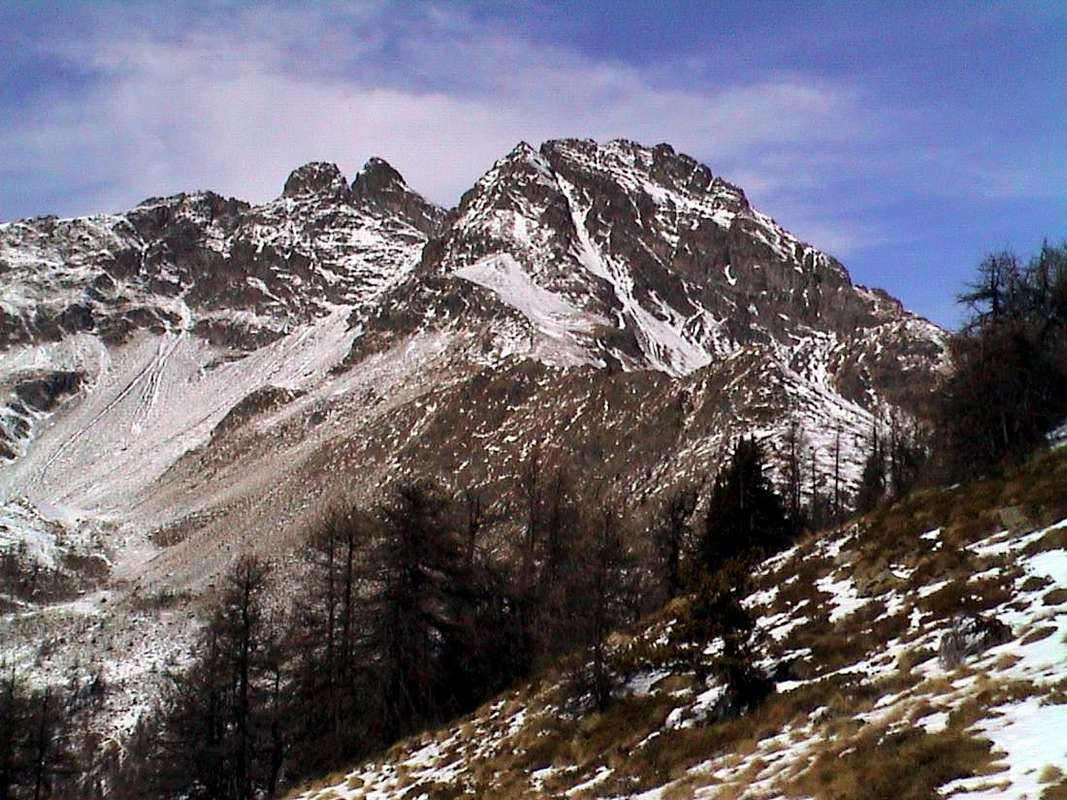
3/C) - Croix de Fana (2.212 m)
Avvicinamento e Via da Trois Villes-Avisod verso la Comba di Senevé o Cénevé: al Villaggio di Avisod (1.390 m; bella chiesetta nel dosso prativo (1.398 m), subito ad Est) prendere verso Occidente la strada poderale, lasciando poco dopo sulla sinistra il bivio per Valseinte (1.399 m; raggiungibile con bella passeggiata tramite il sentiero che dal bel e recentemente ristrutturato Castello di Quart (740 m) transita per l'Oratoire de Saint E'meric (1.140 m) con una splendida passeggiata/escursione); continuare invece più verso Nordovest inserendosi progressivamente nella Conca di Senevé, lasciandosi in basso le Alpi Chacotte (1.426 m) e Séchot (1.409 m). Aggirare le falde boschive del Versante Sudovest della Croix de Fana (2.211/2 m; bella passeggiata con partenza da Trois Villes della quale relazioneremo in futuro) ed, attraversando alcuni piccoli solchi torrentizi, raggiungere l'Alpe Champchamoussin di Sopra (1.856 m); da questa, sempre con salita in diagonale ma più verso Nordovest, raggiungere l'Alpe di Latta o Lattaz (1.930 m; attualmente pressocché in rovina), sottostante al Col Cornet (2.272 m), ed il successivo doppio e largo tornante a quota (2.036 metri). Proseguire, stessa direzione, verso l'Alpe di Chavod (2.038 m), che si lascia dabbasso, ed il successivo tornante in forma di angolo acuto a quota (2.097 metri); da questo la strada poderale cambia direzione in Nordest raggiungendo la quota (2.148 metri), ove arriva il sentiero n° 1 discendente dal predetto colle. Da qui la medesima volge decisamente ancor più ad Occidente raggiungendo in breve tempo l'importante Alpe, da poco tempo ristrutturata, di Senevé (2.199 m; 2h'00/2h'30; non esiston altre possibilità di percorso, poiché il sentiero è stato nel tempo ricoperto dalla vegetazione, dopo la costruzione della strada poderale avvenuta nel corso degli anni '70). Se non si vuol raggiungere l'alpe proseguire dalla congiunzione a (2.148 metri), abbandonando ad Ovest-nordovest la strada poderale che prosegue verso questa, decisamente dapprima verso Sudest e quindi maggiormente ad Est risalendo, tramite il sentiero n° 1, che con tre larghi tornanti conduce al Col Cornet (2.280 m); dal questo, seguendo la cresta spartiacque tra le Combe di Senevé e Dèche) verso Meridione e superando oppure aggirando in genere ad Oriente alcune asperità rocciose-erbose, abbastanza agevolmente e con corta discesina si raggiunge una piccola conca e subito dopo la grande e lignea Croce, posta su d'un minuscolo promontorio (2.212m; 0h'45 dal colletto; F; 1h'30/1h'45 dall'alpe; 3h'30/4h'00 dal Villaggetto di Trois Villes-Avisod).
Variante Bassa: invece di raggiungere il bivio (2.148 metri) a l'Alpe di Senevé, seguire il sentiero, coincidente con una strada poderale, che partendo dall'Alpe Champchamoussin Superiore (1.851 m) si indirizza verso Sud-sudest; raggiunto un largo tornante il medesimo volge a Nord-nordest terminando sotto le pendici Occidentali della Croix de Fana. Da questo punto si tramuta esclusivamente in sentierino che, attraversando la parte superiore del bosco ed alcune costole rocciose, raggiunge la Sommità proprio presso la Croce. Questa via aumenta di quasi 300 metri il dislivello da percorrere, però evita di dover successivamente tornare indietro sullo spartiacque (in pratica stesso tempo e difficoltà).
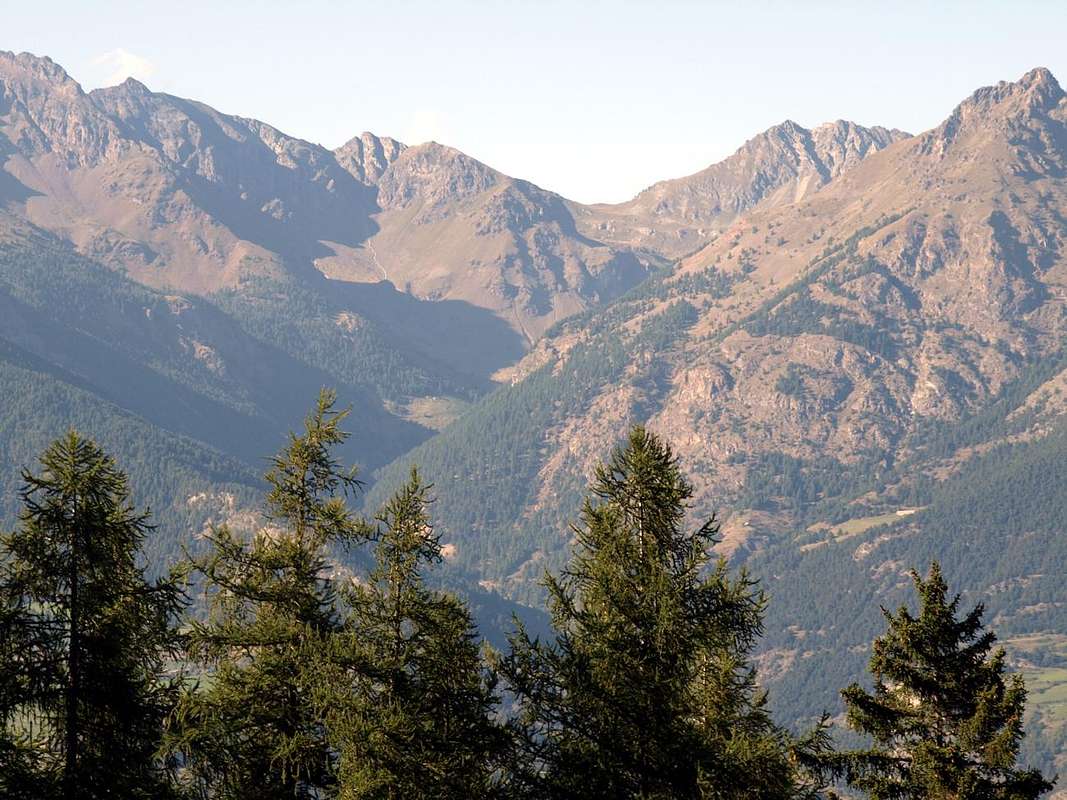
4/A) - Becca Conge (2.954m)
4/A) - Becca Conge (2.954 m)
4/B) - Grand Pays (2.726m)
4/B) - Grand Pays (2.726 m)

4/C) - Becca d'Aveille o Avouille (2.623m)
4/C) - Becca d'Aveille o Avouille (2.623 m)
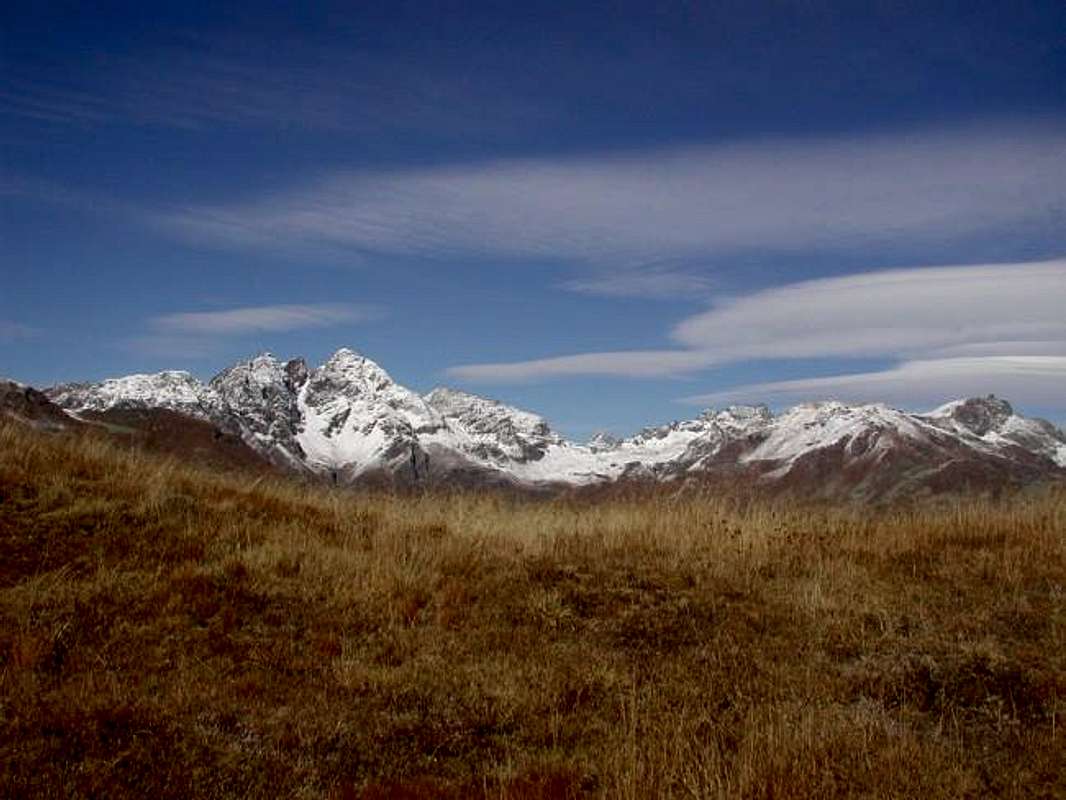
5/A) - Cima Franco Nebbia and Mont Pisonet (3.194m, 3.206m)
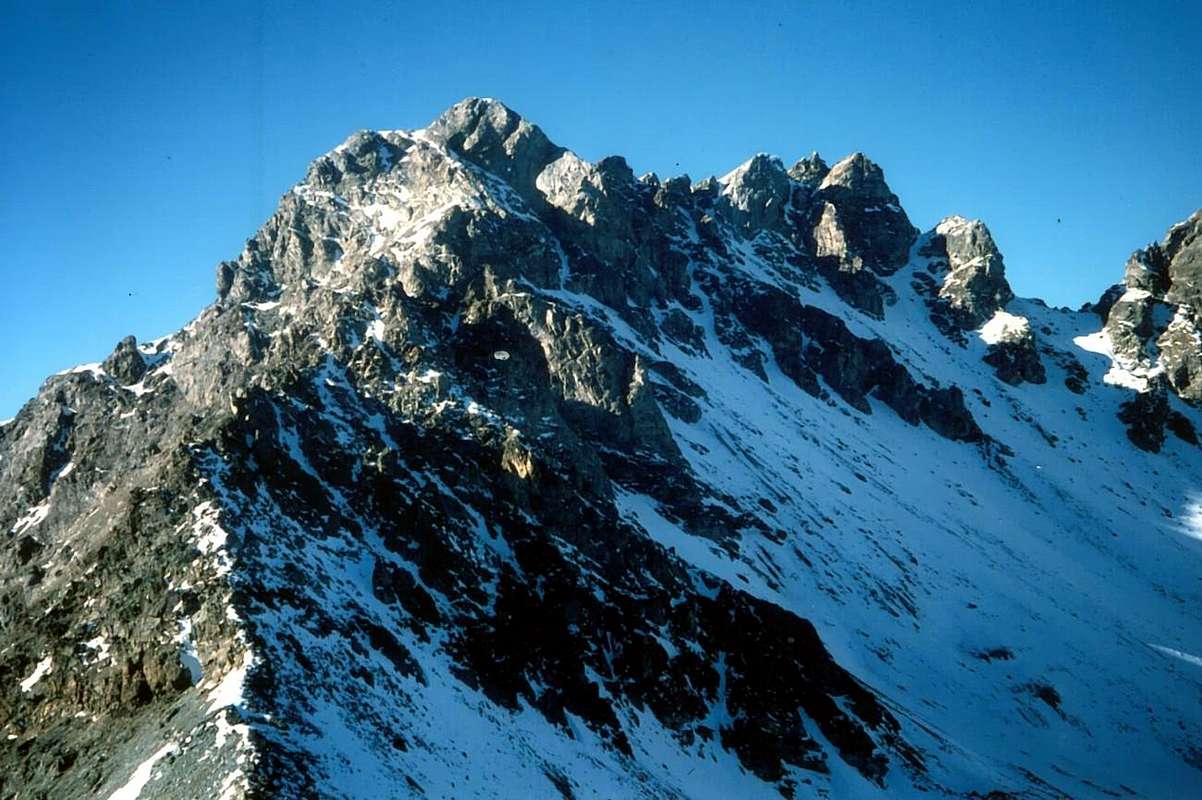
5/A) - Cima Franco Nebbia e Mont Pisonet (3.194 m, 3.206 m)
5/B) - Mont Morion (2.710m)
5/B) - Mont Morion (2.710 m)
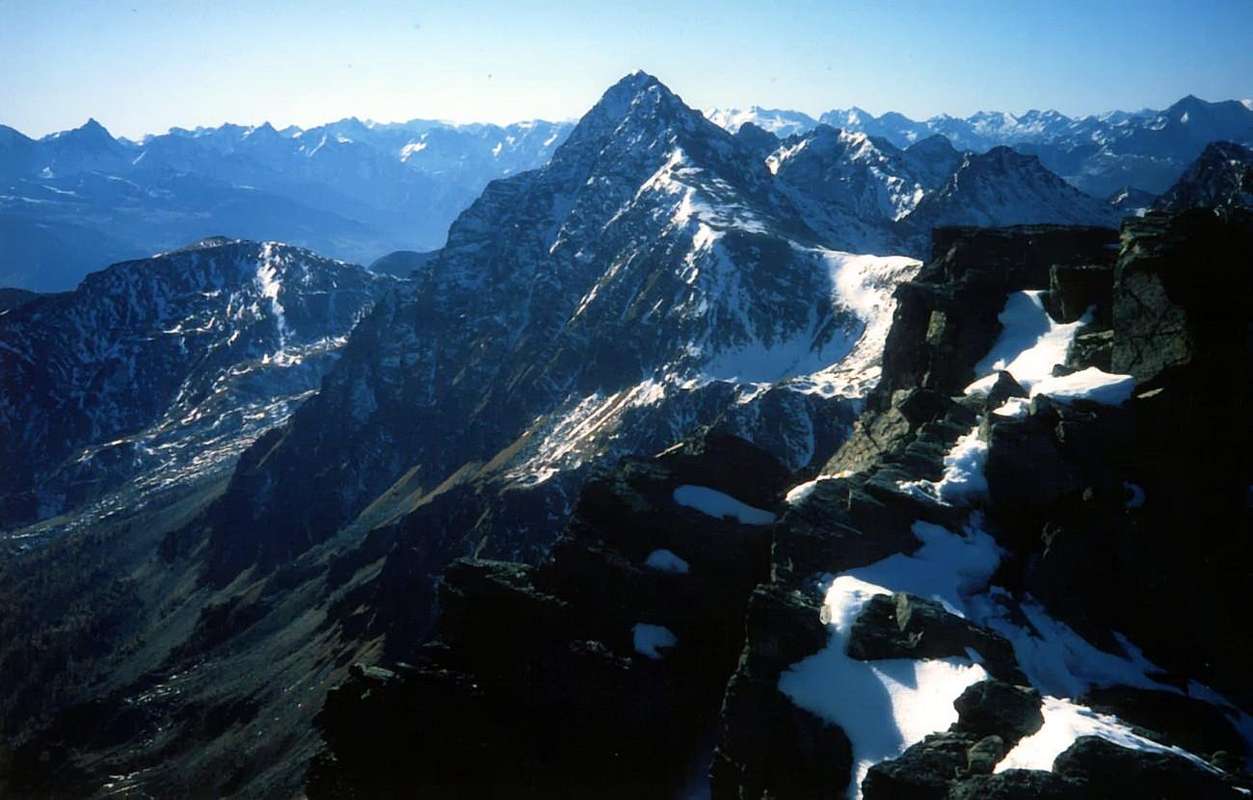
5/C) - Becca Fontaney (2.972m)
5/C) - Becca Fontaney (2.972 m)
Avvicinamento A e via da Lignan tramite il Vallone di Brévaz al Colle di Chaleby (2.653 m) con Via Normale tramite la Cresta Sudest: dall'Uscita dell'Autostrada Aosta Est seguire la Strada Regionale che, attraverso la Valle di Saint Barthélemy, risale fino alla Frazione di Lignan (+; 1633 m; parcheggio). Dal parcheggio di questo villaggio salire verso Nord tramite il sentiero n° 10B/11 fino all'Alpe Place Damon (1.910 m); qui, abbandonando la ramificazione a destra (Est) per l'Alpe Fontane, continuare più verso Nord-nordovest raggiungendo dapprima la strada poderale proveniente dall'Alpe Chaleby (1.952 m) per raggiungere quella successiva di Champanement (2.330 m). Continuando nella direzione primaria raggiungere il sentiero dell'Alta Via numero 1 a quota (2.650 metri circa) e con questa, volgendo decisamente ad Est-sudest, arrivare a Plan Piscina (2.544 m; sorgenti varie) ed in breve tempo al subito soprastante Colle di Chaleby (2.653 m; E/F; 2h'15/2h'30). Avvicinamento B e via da Lignan tramite il Vallone di Fontaney al Col du Salvé (2.569 m): dal bivio di Place Damon, abbandonato a sinistra (Ovest) il precedente sentiero verso Champanement, continuare invece a destra con il sentiero n°11 verso l'Alpe Fontane (2.088 m); * strada poderale da Lignan-Plaisance-Larset) e da questa, sempre con direzione continuamente a Nord dopo un breve giro semicircolare, raggiungere la successiva Tsa di Fontaney (2.307 m). Lasciando ad Est l'Alpe di Chavalary (2.160 m; ** strada poderale da Lignan-Larset), entrare in un valloncello alle pendici Ovest del Mont Morion e, tramite una breve salita appen più ripida, arrivare al Col du Salvé, col quale rapidamente collegarsi a quello di Chalaby (2.569 m; E/F; 2h'30/2h'45).
*** Da questi due colli, inoltre, si può discendere ed attraversare (facile sentiero con un passaggio attrezzato) al'Alpe ed al viciniore Santuario del Cuney (+; 2.653 m).
Via Normale: dal Colle di Chaleby (2.683 m), facilmente raggiungibile sia da Sud ovvero dal Villaggio di Lignan attraverso Plan Piscina quanto da Nord con più lungo percorso arrivando dall'alpe presso il Santuario del Cuney, salire tramite la facile Cresta Sud-sudest; dapprima doppiare un muretto roccioso di colore sulfureo sulla sua sinistra (Sud; (2.755 metri circa) per mezzo di rocce più facili, ma ricoperte da molta erba. Subito dopo un successivo, con le medesime caratteristiche e costituito, inoltre, da buone fasce rocciose sulle quali bisogna saper trovare la via migliore, conduce alla parte terminale che progressivamente diventa sempre più facile e lineare fino al raggiungimento della Cima. Non lasciarsi sedurre da invitanti aggiramenti su di entrambi i lati, poiché il percorso sul filo di cresta risulta sicuramente più semplice, sicuro, migliore ed anche panoramico. (F+; 1h'15/1h'30 dal Colle di Chaleby; 2h'30/2h'45 dall'Alpe Champanement; 3h'40/3h'50 da Lignan, tramite breve connessione ad Ovest-nordovest con il Col du Salvé).
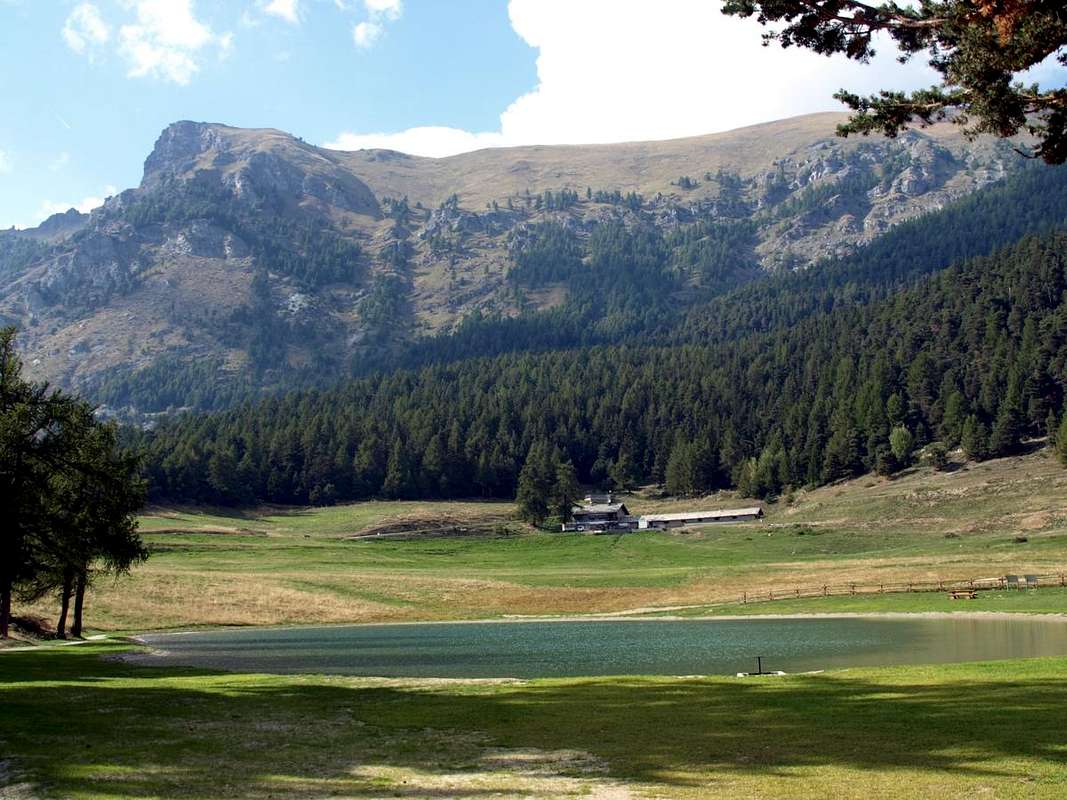
6/A) - Becca d'Aver (2.469m)
6/A) - Becca d'Aver (2.469 m)

6/B) - Mont Andèr (1.931m)
Approach from Vencorère Hamlet: by Grand Villa (1.437m), above Verrayes Common, through the asphalt road reach the Vencorère small Village (1.563m) with the trail not numbered concomitant with the dirt road to Prelaz Alpage (1.712m). This last with path not reported but reduced to very poor track to the Summit (E/F; 1h'15/1h'30).
6/B) - Mont Andèr (1.931 m)
6/C) - Evence (1.750m)
Approach in the Verrayes/St. Denis Basin with departure by the small Villages of Semon, Plau or Del below St. Pantaleon Hill: 1) - Starting from Semon (1.359m) or Plau (1.305m) with private dirt road up to the Hostel Nature of Lavesé (1.500m) and then on path n° 2 or directly from one of Plau always and completely with trail n° 2, reaching the Chapel St. Evence and its crossing on the watershed with Torgnon to Colle St. Pantaleon; down from this through the path n° 1, which starts from the homonymous Chapel reaches Semon and Plau tiny Hamlets and then continue to the below Village Sessina (781 m), at the beautiful Castle of Cly. 2) - Or, wanting a little stretch of the route, from rhe adjacent of Del (1.260m) and from these go up the hill immediately making the circular path as in the first case above described (E/F; 1h'00/1h'30).
6/C) - Evence (1.750 m)
Avvicinamento dai Villaggetti di Semon, Plau o Del sotto al Colle di Saint Pantaleon e sopra il Comune di Saint Denis: 1) - iniziando da Semon (1.359 m) o Plau (1.305 m) con poderale fino all'Ostello Ecosostenibile di Lavesé (1.500 m) per poi inserirsi sul sentiero n° 2, oppure direttamente da quello di Plau sempre e completamente con sentiero n° 2, raggiungendo la Cappella di St. Evence e relativa traversata sullo spartiacque con Torgnon fino al Colle St. Pantaleon; discesa da questo tramite il sentierino n° 1, che partendo dall'omonima Cappella raggiunge i Villaggi Semon e Plau ed indi continuare fino al Villaggio Sessina (781 m), al Castello di Cly. 2) - Oppure, volendo allungare d'un poco il percorso, dall'attiguo Villaggetto di Del (1.260 m) e da questi salire subito al colle compiendo il percorso circolare come nel primo sovradescritto (E/F; 1h'00/1h'30).

7/A) - Mont Zerbion (2.720m)
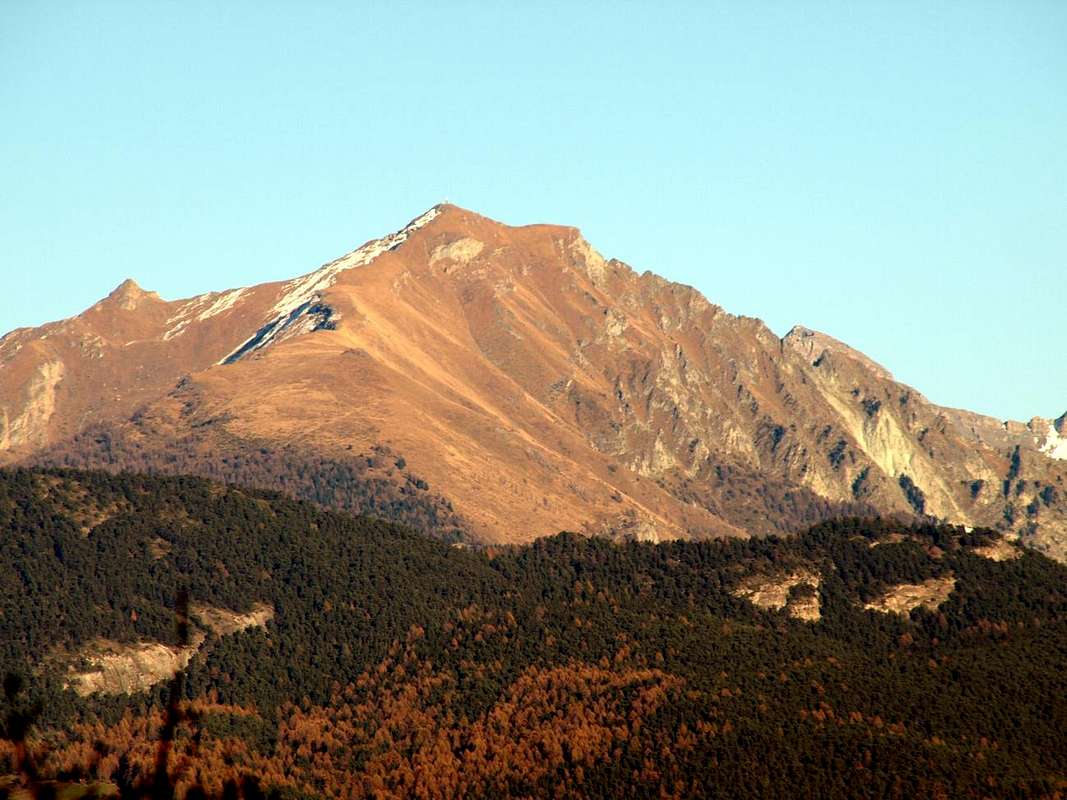
7/A) - Mont Zerbion (2.720 m)
7/B) - Cima Botta (2.042m)
Approach from St. Vincent Town through the Regional Road towards Col de Joux: by Col de Joux (1.623m), reached by St. Vincent-Emarese or from Torgnon, head North with the path n° 12 that passes just above the Alpe Fromy is directed towards that of Nuarsaz below Monte Zerbion. Where this turn to the West, leave the same and go for traces quite steep on the other side to reach the Collar Botta, located between Mont Jetire (2.146m) and Cima Botta and both on the Southeast Ridge that descends from Zerbion; seventy metres fairly steep between blocks whitish and easy rocks in the forest and flexing more towards East leading to the Summit (EE/F; 1h'30/2h'00).
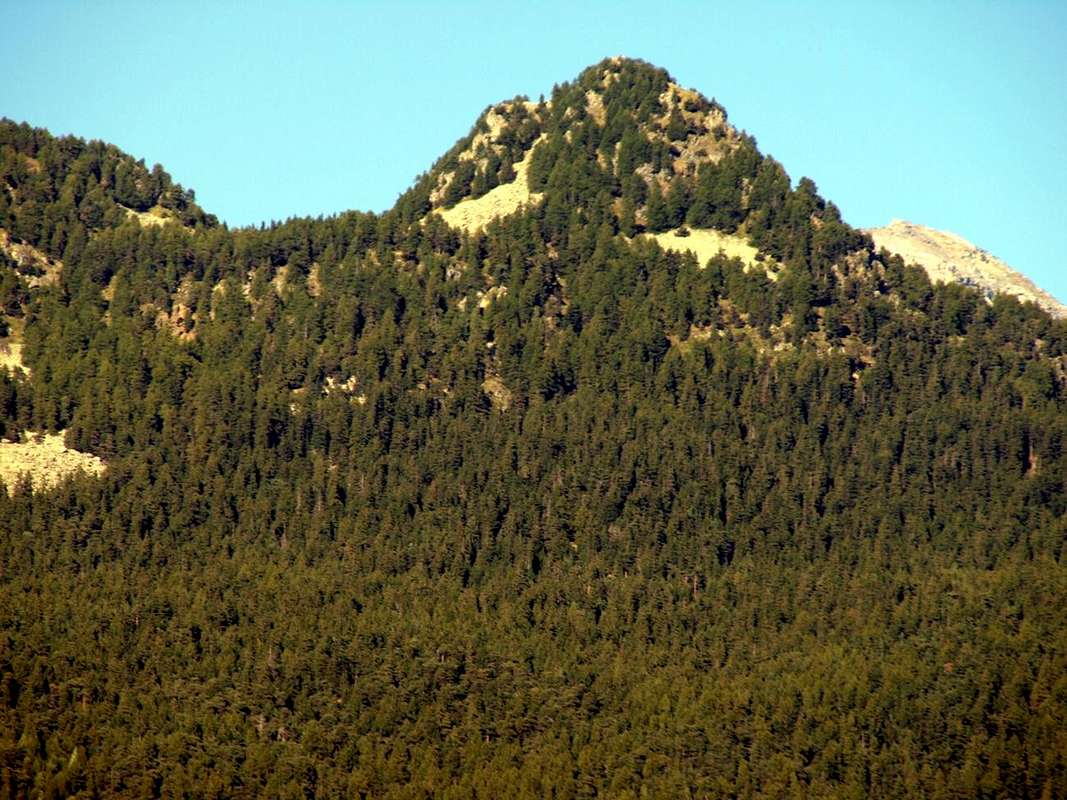
7/B) - Cima Botta (2.042 m)
7/C) - Testa di Comagna (2.106m)
Approach from Emarese Common towards the Hills of Joux or Zuccore or Tzecore with Regional Road: from Saint Vincent Municipality, with Regional Road to Brusson in Val d'Ayas, towards the Joux Hill (1.635m); from this in ascent through small path n° 6 into rhe forest on Northern Slope to Western Shoulder (around 1.930m) and following traverse, through West Crest, to Tête de Comagne (2.106m; great cairn with altar and Cross in Summit; E; 1h'30/1h'45). Or, through the opposite slope, from Col Zuccore (1.607m), reached with Regional Road by Emarese Common (1.048 m), on North Crest into forest and crossing Monte Zuccore (1.882m) with path n° 5 (E/F; 1h'00/1h'15).
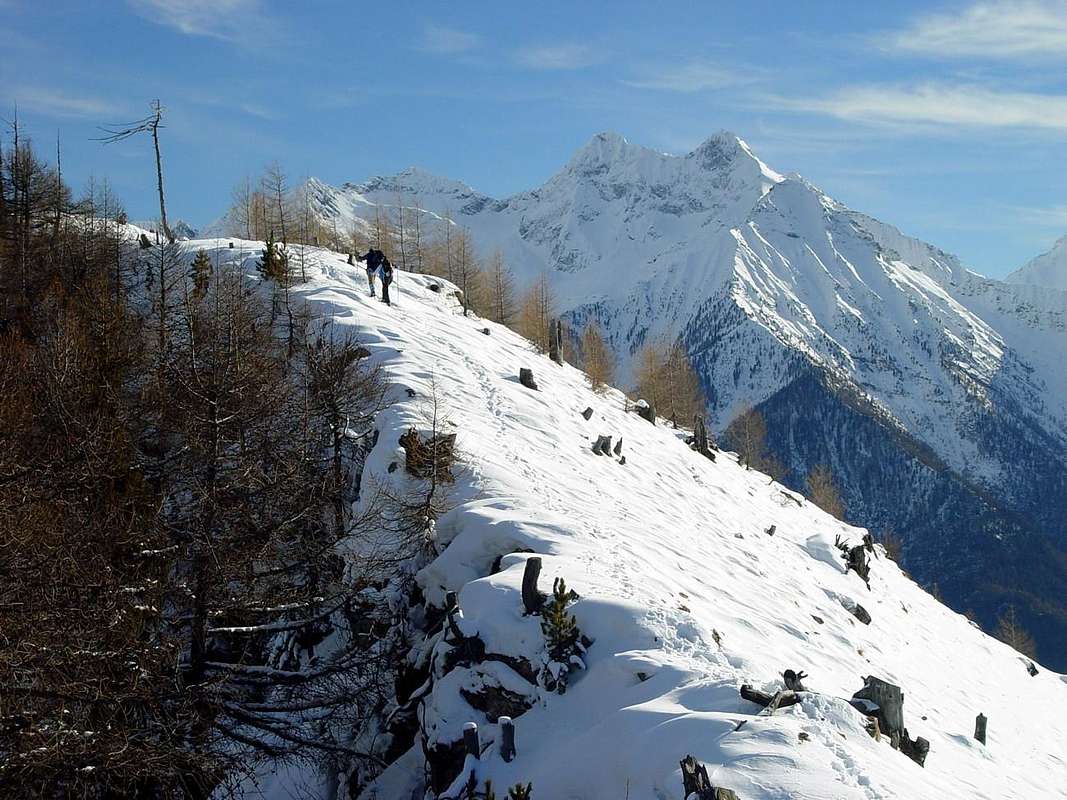
7/C) - Testa di Comagna (2.608 m)

8/A) - Motta or Motte de Pleté and Gran Sometta (2.840m, 2.870m, 3.018m, 3.166m)
8/A) - Motta o Motte de Pleté e Gran Sometta (2.840 m, 2.870 m, 3.018 m, 3.166 m)
Avvicinamento dal Comune di Valtournanche verso il Colle delle Cime Bianche: dalla Strada Regionale presso la località Varvoyes (1.844 m) e, tramite la poderale, verso le Alpi di Promindoz de Meitin e Damon (1.932 m, 2.026 m), Mandaz, Mandaz Dèsott e Damon (2.113 m, 2.315 m), Molar (2.315 m), Cleyva Groussa (2.253 m), Illiaz Perron (2.249 m), Gran Plan (2.510m) con sentieri n° 19/21; da qui al bivio 2.599 metri e sempre con sentiero n° 21 verso Nordovest, guadando il Torrent Cleyva Groussa, alla Motte de Pleté Cima Occidentale (2.840 m), tramite l'elementare Versante Sudest. Facilmente artraversare sullo spartiacque alla Motta Centrale (2.870 m), all'Orientale (3018 m) ed insino alla Vetta della Gran Sometta, per mezzo della facile Cresta Ovest (3.166 m; E/F; 3h'30/4h '00), sita tra i Colli Nordest (2.985 m) e Sudovest (2.894 m) delle Cime Bianche.

8/B) - Mont Tantané (2.734m)
8/B) - Mont Tantané (2.734 m)
Avvicinamento dalla Strada Regionale verso il Comune di La Magdeleine: da Antey Saint André-Petit Antey (1.092 m) con la Strada Municipale verso i Villaggetti di Chaillein, Noussan (1.509/1.474 m), bivio 1.307 metri, presso il Dalai Lama Camping (1.499 m) ed all'importante Villaggio di Promiod (+; 1.505 m). Da questo, tramite poderale-sentiero n°12 a Nordest, in direzione dei pascoli di Boettes (1.722 m) Pasture nonché dei successivi Alpeggi di Supplin (1.914 m), Brovié (1.908 m), Renard (2.046 m) e delle deviazioni 2.118, 2.165, 2.252 and 2.354 metri verso il Col Portola tramite il Versante Occidentale (2.414 m; E/F; 2h'45/3h'15), collocato tra Mont Tantané e Zerbion (2.720 m) sullo spartiacque Valtournanche/Ayas Valleys. Dal colle seguire la Cresta Sud con il sentiero n°9 che, sotto cresta oppure sul filo e superando le quote rocciose 2.474, 2.488, 2.509, 2.541, 2.628 metri, raggiunge lo Spallone Est (2.682 m); una breve discesa porta alla larga sella 2.637 metri e subito dopo alla Cima (EEA/F/F+; 3h'30/4h'00 da Promiod).
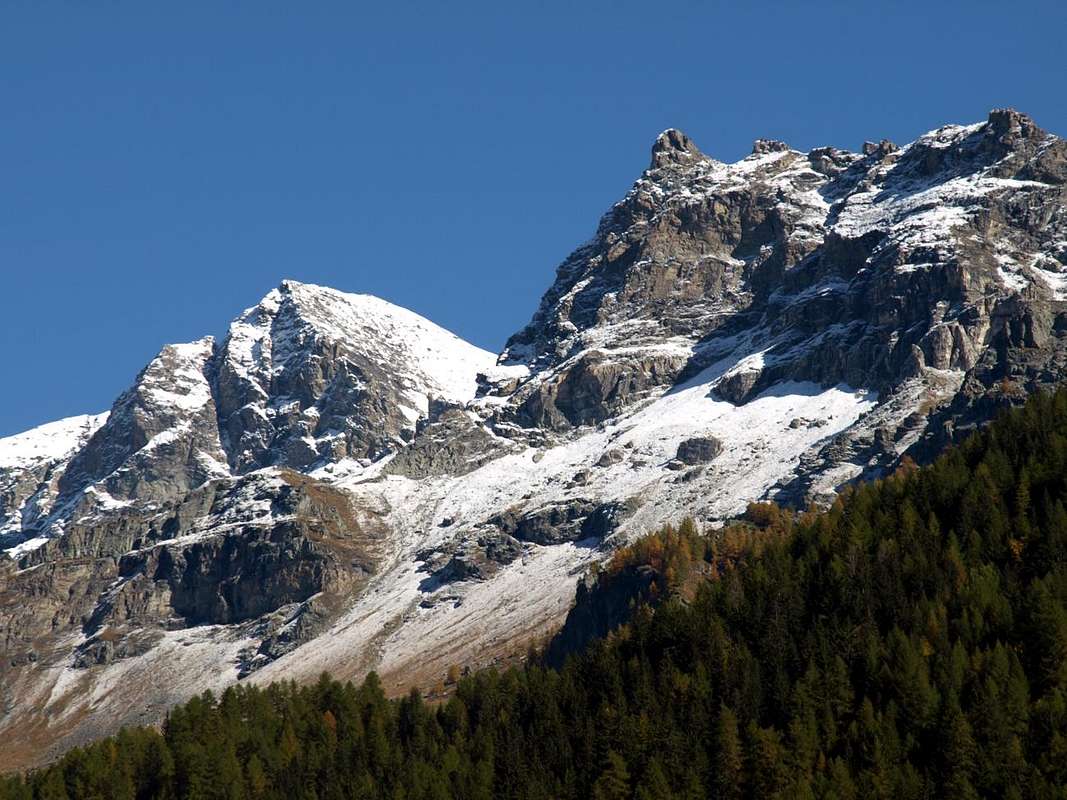
8/C) - Becca d'Aran (2.953m) and Mont Roisetta (3.332m)
8/C) - Becca d'Aran (2.953 m) e Mont Roisetta (3.332 m)
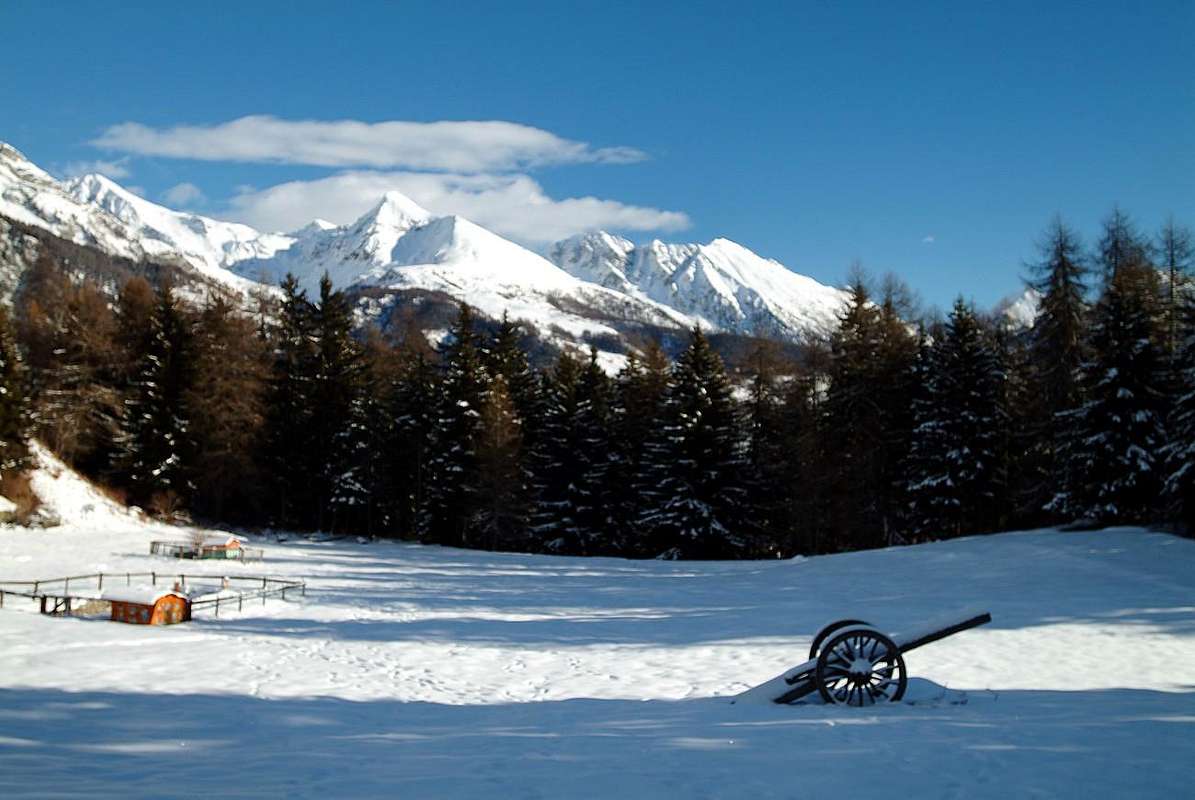
8/Cbis) - Mont Roisetta (3.332m)
8/Cbis) - Mont Roisetta (3.332 m)
9/A) - Testa Grigia (3.316m)

9/A) - Testa Grigia (3.316 m)

9/B) - Corno Bussola (3.023m)
9/B) - Corno Bussola (3.023 m)
Avvicinamento dal Vallone dal Vallone di Palasina: da Brusson salire al Villaggio di Estoul (+; 1.818 m; ampio parcheggio con pannelli e varie segnalazioni) tramite la Strada Regionale; da qui, verso Settentrione con la poderale dapprima concomitante ai sentieri n° 5/4/105, verso i vari Alpeggi di Fenillettaz (1.840 m), il successivo bivio (1.882 m; segnale di divieto per i mezzi), Fontaine (1.903 m), Chanlochère (2.012m), bivio 2029 metri, Chavanne (2.107m), le due alternative (2.103 m, 2.209 m) viciniori al Lago Litteran (2.226 m), bivio 2.231 metri. Da questo punto A) - : a Nordovest in direzione delle Alpi Chavanne (2.347 m) e Palasinaz (2.402 m) verso la 1) - "Baita Dino" (circa 2.435 metri; casa privata); dalla stessa, dapprima con sentiero n° 4/105 in un valloncello e lungo l'emissario e quindi presso la sponda Nord del Lago della Battaglia verso i Laghi Pocia e Lungo. Con sentiero n° 3C ad Ovest-nordovest al di sopra d'un promontorio detritico raggiungere il largo Colle Bussola (2.807 m); continuare a Nordovest sulla facile Cresta Sudest con sentierucolo sino al 2) - Corno Bussola (+; 3.023m; EE/F+, breve passaggio attrezzato con catene; 3h'30/4h'00 da Estoul; 1h'45/2h'15 dalla "Baita Dino").
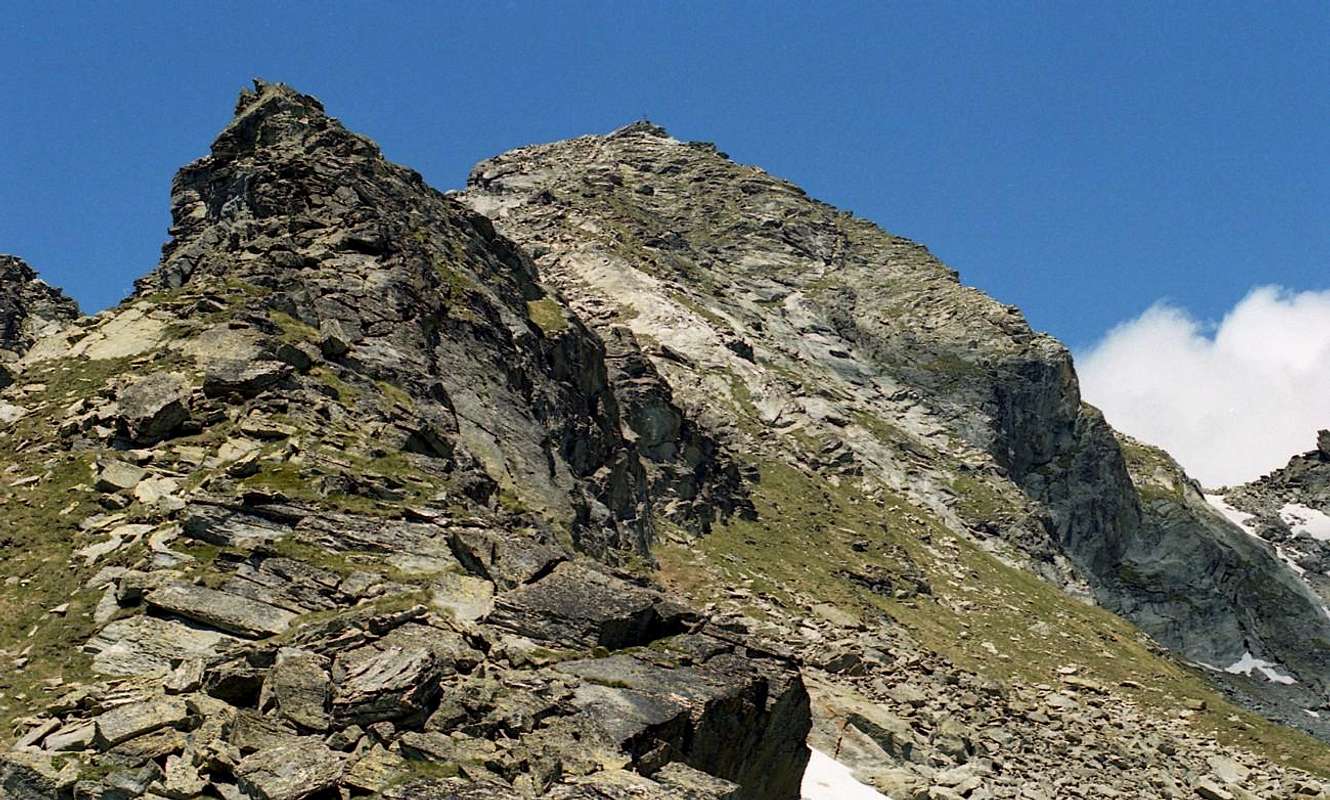
9/C) - Becca Torché (3.016m)
b) - Through Southwestern Slope from the more in bottom Chalex Alpages (1.780m) (EE/A/PD-; about 02h'30/03h'00 from upper rocky base; 07h'00/08h'00 Isollaz).
c) - Through Northwestern Ridge from le Tron Alp. This long ridge coming down from the Northwest to the Tip Meriaoù can also be reached from the Vallon of the same Dondeuil reaching from the Alp le Tron to the saddle of 2.700 meters after Becca Mortens and proceeding fairly smoothly on wire of the same (A; from PD- to PD+; about 03h'00/03h'15 from le Tron Alpahe; 07h'30/08h'30 from Isollaz Hamlet). Better to walk away from this with ascent through the Chasten Vallon from Tollegnaz Village, because the search for the via forward is simpler and requires less knowledge of the area being more visible. But even this route is as a way little known and rarely traveled.
9/C) - Becca Torché (3.016 m)
Avvicinamento dal per il Vallone Occidentale del Dondeuil: questa Cima risulta come la più elevata dell'intero vallone che simbolicamente rappresenta, poi connettendosi verso Oriente con la "gemella" Becca di Vlou (+ 3.032 m). Un elegante connubio, ma mentre la Torché "si distende" verso il Vallone del Dondeuil, l'altra é completamente collocata nella Valle di Gressoney o del Lys dominando le piccole Valli di Scheity ed Issime. Insieme, formano le cosiddette "Dames de Challand", grazie all'esposizione che mostrano verso questo lato con le loro due magnifiche Pareti Nord, sempre ben in vista passando per la Valle d'Ayas medio-alta; mentre sul versante opposto s'evidenziano con minor risalto. La Torché dal versante Dondeuil non offre alcun particolare tipo di scalata, ma propone una piacevole passeggiata attraverso la sua Via Normale percorrente la Via Alpina verso Gressoney. Pur evidenziandone la facilità si deve sottolineare la presenza d'una delicata traversata d'una cinquantina di metri sulla destra appena oltre il colle, tramite una cengia erbosa da affrontarsi con cautela perché molto esposta a Sudest. Devesi inoltre differenziare come l'escursioni cambi aspetto completamente in partenza dalle Alpi Dondeuil (avendo il permesso di prendere la strada privata in auto), o, a partire dal Isollaz, con il percorso completo di tutto il Vallone del Dondeuil; in questo caso, "riemerge" un vecchio modo di andare in montagna con una bella "sfacchinata", richiedente più che buoni garretti ed una buona dose di pazienza. In ogni caso, è bello, piacevole e panoramico viaggio.
a) - Tramite la facile Cresta Meridionale o Via Standard dal Col Dondeuil (2.338 m). Dopo la traversata di cui sopra, seguire facilmente il sentiero non numerato né segnalato risalente sullo spartiacque o ad Est appena sotto al medesimo (EE/F; 01h'30/02h'15 dal colle; 03h'45/04h'15 dall'Alpe Dondeuil; 07h'15/07h'45 dal Villaggio di Isollaz).
b) - A mezzo del Versante Sudovest partendo dagli Alpeggi di Chalex (1.780 m) (EE/A/PD-; 02h'30/03h'00 circa dalla base superiore; dalle 07h'00 alle 08h'00 da Isollaz).
c) - Con la Cresta Nordovest dall'Alpe le Tron. Questa lunga cresta discende a Nordovest in direzione della Punta di Meriaoù ma é inoltre raggiungibile dallo stesso Vallone del Dondeuil raggiungendo dall'Alpe le Tron la sella a quota 2.700 metri dopo la Becca Mortens e procedendo abbastanza agevolmente sul filo dello stesso (A; da PD- a PD+; 03h'00/03h'15 circa da le Tron; 07h'30/08h'30 da Isollaz). Risulta meglio non procedere con questo vallone utilizzando quello di Tollegnaz Chasten, perché la ricerca della via di salita è più semplice e richiede meno conoscenza del territorio ed é facilmente più individuabile. Anche questa risulta come via poco conosciuta e assai raramente percorsa.
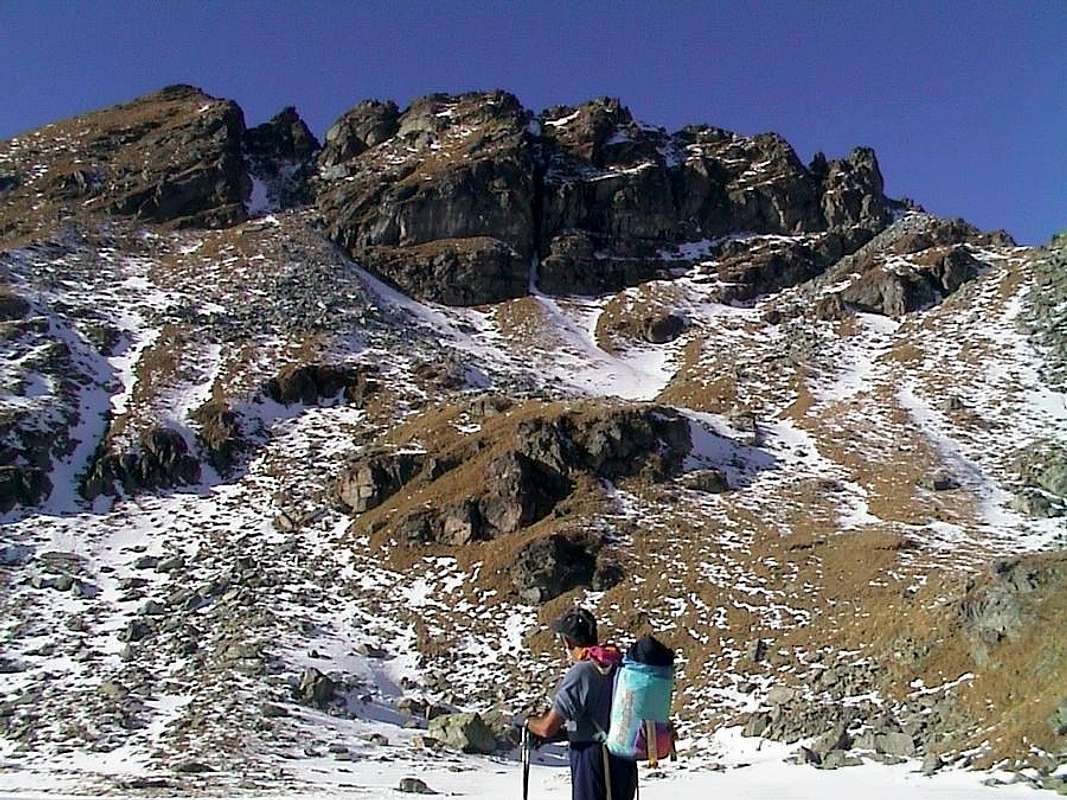
9/D) - Punta di Valfredda (2.947m)
9/D) - Punta di Valfredda (2.947 m)
Avvicinamento dal Vallone dal Vallone di Palasina: dal Villaggio di Estoul (1.818 m; grande parcheggio con pannelli e segnalazioni varie) dapprima verso Nordovest poi Nord tramite la Streda Regionale; dal villaggio, con direzione a Settentrione per mezzo della poderale concomitante al sentiero n° 5, verso gli Alpeggi di Fenillettaz (1.840 m), successivo bivio (1.882 m; segnale di divieto al transito per i mezzi non autorizzati), Fontaine (1.903 m), Chanlochère (2.012 m), bivio 2.029 metri, Chavanne (2.107 m), biforcazioni 2.103, 2.209 metri nelle vicinanze del Lago Litteran (2.226 m), successivo bivio 2.231 metri. Da quest'ultimo, lasciata a sinistra la poderale che prosegue verso il soprastante Rifugio Arp (2.446 m), seguire invece una piccola traccia presso il torrentello verso Est-nordest fino al sentiero n° 5D/105 che raggiunge il Colle di Valnera o Valdònierfòrkò (2.673/6 m); da questo, tramite la facile Cresta Sudest con percorso semicircolare e qualche roccetta finale, raggiungere la Cima (EE/F; 3h'15/3h'45 da Estoul).
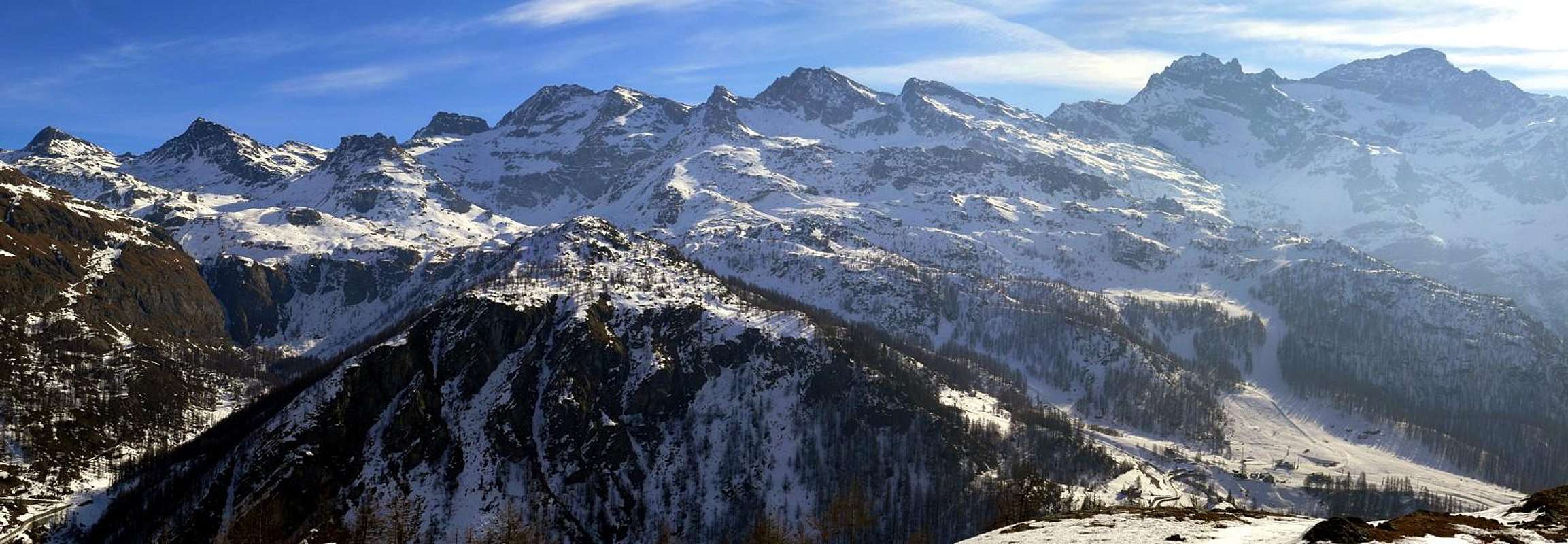
Approach from dirt road towards the lake: from Gressoney La Trinité, at the end of the Gressoney Valley, to Parking between Fòhré/Enge (1.798m) small Villages (* Departure of a first Chair Lift to alp 1.910 meters and from this an other chair to dirt road immediately below Gabiet Loch), with Main Road; also to Obrò de Jòlò (1.837m). From alternative (+; 1.801m; signal no transit and parking) just before, through dirt road in Southeast, towards Montery, Tschòcke (1.926m) Pastures, alternatives 1941m, 1.989m, Recka (2.131m), Shéttò Alpages, near Lys Refuge (2.339m; **arrival Cableway from Staffal). From this briefly to a) - Gabiet Refuge and Loch (2.370m, 2.363m; T; 0h'10); from Lys Refuge, through dirt road in North, to neighbor Ponte Shelter (2.388m) and, doubling West the Schwoarzehòre (2.710m), through path on moraines in East, to b) - Zube Pass (2.871m), between Corno Rosso or Rothòre (3.023m) and Punta Straling (3.115m). Also continue in North-northeast, always through dirt road, to c) - Salati Pass (2.931m), between Stoleberg (3.202m) and Corno del Camoscio (+; 3.026m). You and still, through dirt road in Northeast, towards the d) - pond 2.721 meters and d'Olen Hill (2.880m), above Guglielmina and Città di Vigevano Refuges (2.863m), now immediately but completely in Piedmont Region. From the both hills eaily to Corno del Camoscio (E/F; 4h'00/4h'30 from Fòhré/Enge or from Obrò de Jòlò Villages; 1h'45/2h'15 from Gabiet Loch or from the Gabiet, Lys, Ponte Shelters, all three in the same vicinity of the lake).
10/A) - Corno del Camoscio (3026 m) dal Lago Gabiet (2.363 m)
Avvicinamento dalla poderale per il lago: da Gressoney La Trinité, al termine della Valle di Gressoney, al Parking tra i Villaggetti di Fòhré ed Enge (1.798 m) (* Partenza del primo troncone della Funivia verso l'alpeggio a 1.910 metri e da questo tramite il successivo verso la poderale immediatamente al di sotto del Lago Gabiet), per mezzo della Strada Principale; oppure in direzione di Obrò de Jòlò (1.837 m). Dal bivio (+; 1.801 m; divieto di transito e parcheggio) appena prima, con poderale a Sudest, verso le Alpi Montery e Tschòcke (1.926 m), biforcazioni 1.941 metri e 1.989 metri e gli Alpeggi di Recka (2.131 m) e Shéttò, presso il Rifugio del Lys (2.339 m; **arrivo della Funivia da Staffal). Da questo in breve tempo con diverse possibilità verso il a) - Rifugio del Gabiet e Lago (2.370 m, 2.363 m; T; 0h'10); dal Rifugio del Lys, tramite poderale verso Nord, verso il vicino Rifugio Ponte (2.388 m) e, doppiando ad Ovest il Schwoarzehòre (2.710 m), tramite sentiero ad Est nelle morene, al b) - Passo di Zube (2.871 m), posto tra Corno Rosso o Rothòre (3.023 m) e Punta Straling (3.115 m). Oppure continuare verso Nord-nordest, sempre a mezzo di poderale, verso il c) - Colle dei Salati (2.931 m), collocato tra lo Stoleberg (3.202 m) ed il Corno del Camoscio (+; 3.026 m). Od ancora, con poderale in Nordest, verso il d) - laghetto 2.721 metri ed il Col d'Olen (2.880 m), al di sopra dei Rifugi Guglielmina e Città di Vigevano (2.863 m), adesso immediatamente ma completamente in Regione Piemonte. Da entrambi i colli e facilmente al viciniore Corno del Camoscio (E/F; 4h'00/4h'30 dai Villaggi di Fòhré/Enge o da Obrò de Jòlò; 1h'45/2h'15 dal Lago del Gabiet oppure dai Rifugi Gabiet, Lys e Ponte, tutti e tre nelle vicinanze del lago).
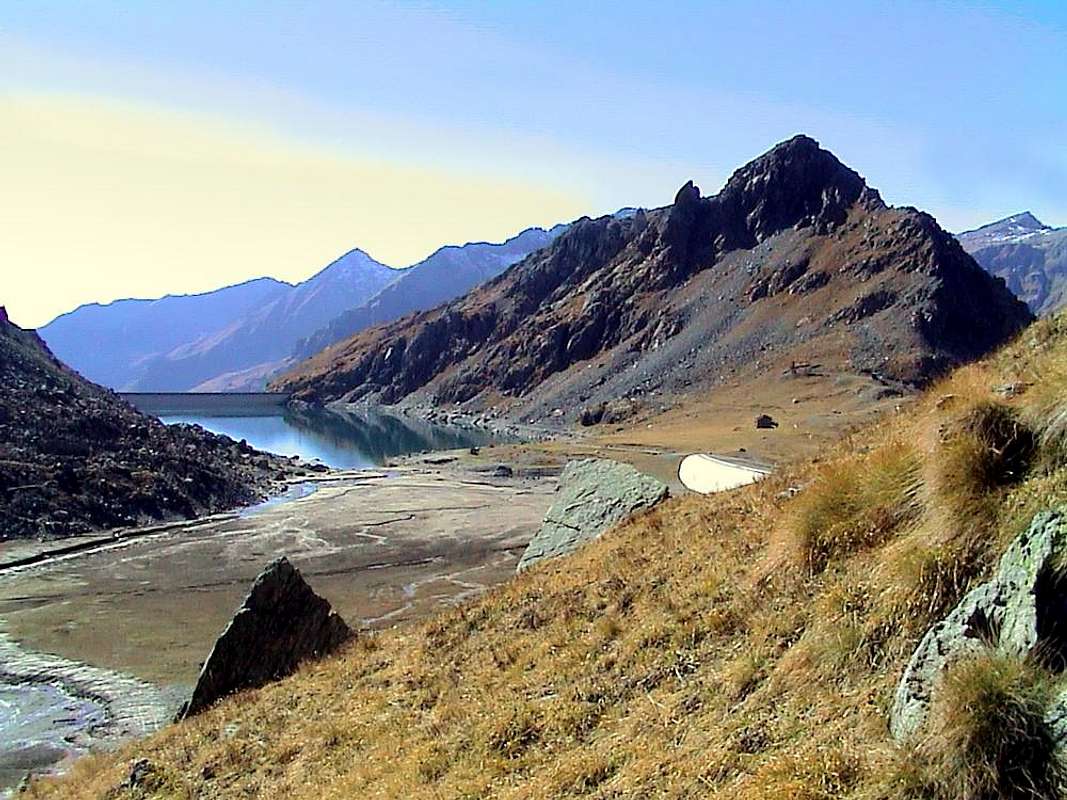
10/B) - Mont Ciosé or Stallenhorn (2.664m)
10/B) - Mont Ciosé o Stallenhorn (2.664 m)
Avvicinamento dal Comprensorio d'Estoul tramite il Colle della Ranzola: da Estoul, per mezzo della poderale concomitante con il sentiero n° 7 verso Oriente, verso gli Alpeggi di Fenillettaz, Murassaz (1.883 m), Praz Barmasse Dèsott (1.928m; segnale di divieto al transito dei mezzi), bivio 2.014 metri, Alpe Fenêtre (2.083 m) in direzione del Colle della Ranzola o Arescoll (2.171 m; T; 1h'20/1h'40), sito tra il Mont Ciosé o Stallerhòre (2.647 m) e la Punta della Regina (+; 2.387 m). Da questo verso Nord-nordovest al Mont Ciosé, per mezzo della Cresta Sud-sudest superando con qualche roccetta le varie quote 2.401, 2.403, 2.473, 2.559, 2.621, l'esposto a Nordest intaglio 2.611 (I°+/II°-), 2.629 metri (EEA/F+/PD-; 3h'00/3h'15). Conviene effettuare la discesa tramite una costola del Versante Sud in direzione dell'Alpeggio Praz-Barmasse Damon (2.038 m; I°).
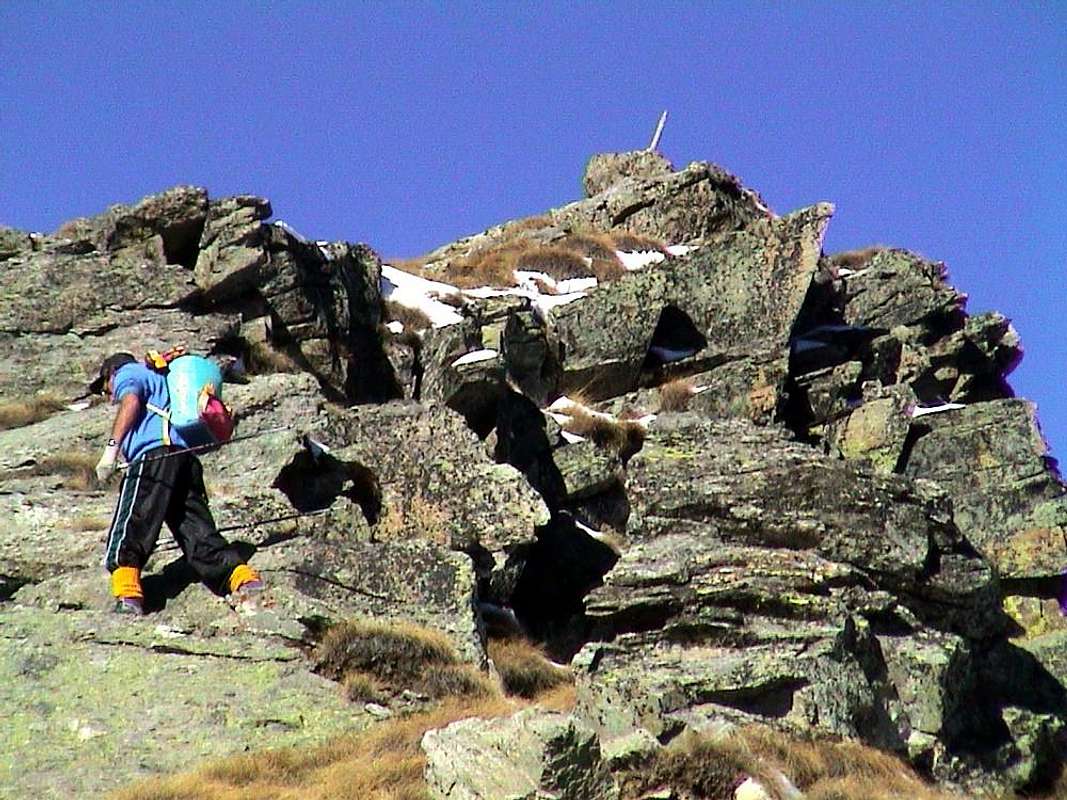
Campings
Remember that free camping is forbidden (except for emergency reasons, over 2.500m, from darkness until dawn).Mountain Condition
- Meteo: you can find all the needed informations at the official site of the Valle d'Aosta Region:
- Valle d'Aosta Meteo
Important Information
- REGIONE AUTONOMA VALLE D'AOSTA the official site.
- FONDAZIONE MONTAGNA SICURA Villa Cameron, località Villard de la Palud n° 1 Courmayeur (AO) Tel: 39 0165 897602 - Fax: 39 0165 897647.
- A.I.NE.VA. (Associazione Interregionale Neve e Valanghe).
Useful numbers
- Protezione Civile Valdostana località Aeroporto n° 7/A Saint Christophe (Ao) Tel. 0165-238222.
- Bollettino Meteo (weather info) Tel. 0165-44113.
- Unità Operativa di Soccorso Sanitario Tel. 118.






